Router: Unterschied zwischen den Versionen
Emploi (Diskussion | Beiträge) K (→Router) |
|||
| (192 dazwischenliegende Versionen von 6 Benutzern werden nicht angezeigt) | |||
| Zeile 11: | Zeile 11: | ||
== Router == | == Router == | ||
| + | ===Leistungsstarke Geräte=== | ||
| − | {| class="wikitable sortable zebra toptextcells" | + | '''Mindestanforderungen:''' |
| + | * Zwei- oder Vier-Kern Prozessor | ||
| + | |||
| + | {| class="wikitable sortable zebra toptextcells" style="background:#a0ffa0; | ||
|- | |- | ||
! Geräte-Name | ! Geräte-Name | ||
| Zeile 21: | Zeile 25: | ||
! Mhz/[https://de.wikipedia.org/wiki/System-on-a-Chip SoC] <br> ([[Router technische Details|CPU-Leistung]]) | ! Mhz/[https://de.wikipedia.org/wiki/System-on-a-Chip SoC] <br> ([[Router technische Details|CPU-Leistung]]) | ||
! [https://www.elektronik-kompendium.de/sites/net/1004251.htm MIMO] 1x1:1 | ! [https://www.elektronik-kompendium.de/sites/net/1004251.htm MIMO] 1x1:1 | ||
| − | ! class="unsortable" | Version (<span style="color: green">tested</span>) | + | ! class="unsortable" | Version[EAN] (<span style="color: green">tested</span>) |
! class="unsortable" | Beschreibung | ! class="unsortable" | Beschreibung | ||
| − | ! LAN-Adresse OriginalFW (Nutzername<br>Password) | + | ! Schwierigkeitsgrad <br> LAN-Adresse OriginalFW (Nutzername<br>Password) |
! Wirkleistung | ! Wirkleistung | ||
|- | |- | ||
| − | | Xiaomi AX3200<br>[[Datei:Xiaomi AX3200 Redmi ax6s.jpg|100px|rahmenlos]] | + | | Xiaomi AX3200<br>(Redmi AX6S)<br>[[Datei:Xiaomi AX3200 Redmi ax6s.jpg|100px|rahmenlos]] |
| [https://www.mi.com/de/product/xiaomi-router-ax3200/specs/ Xiaomi] <br>2021/07 | | [https://www.mi.com/de/product/xiaomi-router-ax3200/specs/ Xiaomi] <br>2021/07 | ||
| − | | style="text-align:right" | 80€ UVP | + | | style="text-align:right" | 80€ UVP |
| style="text-align:right" | 256 | | style="text-align:right" | 256 | ||
| style="text-align:right" | 128 | | style="text-align:right" | 128 | ||
| − | | 1350/MediaTek [https://wikidevi.wi-cat.ru/MediaTek_MT7622 MT7622B]<br>A53 64Bit DualCore<br> (2Cores/2Threads) | + | | 1350/MediaTek [https://wikidevi.wi-cat.ru/MediaTek_MT7622 MT7622B]<br>ARM A53 64Bit DualCore<br> (2Cores/2Threads) |
| − | | 4x4:4@2,4Ghz<br>4x4:4@ | + | | 4x4:4@2,4Ghz<br>4x4:4@5Ghz ax |
| − | | AX3200 | + | | AX3200 <span style="color: green">RB01[6934177754951]</span> |
| − | | 3 LAN:1 WAN (1Gbit), 2,4Ghz und 5Ghz (AX) WLAN, 6 feste Antennen <br> | + | | 3 LAN:1 WAN (1Gbit), 2,4Ghz und 5Ghz (AX) WLAN, 6 feste Antennen <br> |
| − | | 192.168.31.1/24(LAN) | + | | <span style="color: red"> Kompliziert</span> <br> 192.168.31.1/24(LAN) <br> Anleitung: [[Router_einrichten_Xiaomi_AX3200_Redmi_ax6s|Router einrichten Xiaomi AX3200]] |
| − | | Originalnetzteil ( | + | | Originalnetzteil 12V/1,5A(18W) <br> 5,9W(Leerlauf+2xGBLAN) 6,6W(Vollast) <br> |
| + | |- | ||
| + | | TP-Link RE650 AC2600<br>[[Datei:TP-Link RE650v1.0.jpg|100px|rahmenlos]] | ||
| + | | [https://www.tp-link.com/de/home-networking/range-extender/re650/ TP-Link] <br>2021 | ||
| + | | style="text-align:right" | 85€ UVP | ||
| + | | style="text-align:right" | 128 | ||
| + | | style="text-align:right" | 16(v1)<br><span style="color: red"> 8(v2) </span> | ||
| + | | 880/MediaTek [[MT7621|MT7621AT]]<br>DualCore SMT<br> (2Cores/4Threads) | ||
| + | | 4x4:4@2,4Ghz<br>4x4:4@5Ghz ac | ||
| + | | <span style="color: green">v1.0[6935364094348] </span> <br> <span style="color: green">v2.1[]<br></span> | ||
| + | | 1 LAN (1Gbit), 4 feste kombinierte Antennen, LED-Ausschalter | ||
| + | | <span style="color: green">Einfach</span> <br> 192.168.0.254/24(LAN) <br> (per Webinterface) <br> (ab 8.1.7) | ||
| + | | Original (100-240V0.4A) <br> 4,6W(Leerlauf) | ||
|- | |- | ||
| − | | Xiaomi Redmi Router AC2100 <br>[[Datei: | + | | Xiaomi Redmi Router AC2100 <br>[[Datei:Xiaomi Redmi Router AC2100.jpg|100px|rahmenlos]] |
| [https://www.mi.com/rm2100 Xiaomi] <br> 2019/11 | | [https://www.mi.com/rm2100 Xiaomi] <br> 2019/11 | ||
| − | | style="text-align:right" | | + | | style="text-align:right" | ab 45€ (neu) |
| style="text-align:right" | 128 | | style="text-align:right" | 128 | ||
| style="text-align:right" | 128 | | style="text-align:right" | 128 | ||
| Zeile 47: | Zeile 63: | ||
| <span style="color: green">.</span> | | <span style="color: green">.</span> | ||
| 3 LAN (1Gbit): 1 WAN, 2,4Ghz und 5Ghz (AC) WLAN, 6 feste Antennen | | 3 LAN (1Gbit): 1 WAN, 2,4Ghz und 5Ghz (AC) WLAN, 6 feste Antennen | ||
| − | | | + | | <span style="color: orange"> Anspruchsvoll</span> <br> |
| | | | ||
| + | |- | ||
| + | | D-Link COVR-X1860<br>[[Datei:D-LinkCOVR-X1860.jpg|100px|rahmenlos]] | ||
| + | | [https://eu.dlink.com/de/de/products/covr-x1862-x1863-ax1800-dual-band-whole-home-mesh-wifi-6-system D-Link] <br> 2023 | ||
| + | | style="text-align:right" | EOL!!! Gebraucht ca. 40€ pro Paar (10/24 LA) | ||
| + | | style="text-align:right" | 256 | ||
| + | | style="text-align:right" | 128 | ||
| + | | 880/MediaTek [[MT7621|MT7621AT]]<br>DualCore SMT<br> (2Cores/4Threads) | ||
| + | | 2x2:2@2,4Ghz ax<br>2x2:2@5Ghz ax | ||
| + | | <span style="color: green">A1</span>[790069459030] | ||
| + | | 1 LAN (1Gbit): 1 WAN, 2,4Ghz (AX) und 5Ghz (AX) WLAN, 4 interne Antennen | ||
| + | | <span style="color: green">Einfach</span> <br>192.168.0.1 (per LAN/WLAN) <br> [[Router_einrichten_COVR-X1860|Router einrichten COVR-X1860]] | ||
| + | | Originalnetzteil 12V/1A(12W) <br> 4,5W(Leerlauf+2xGBLAN) <br>3,9W(LeerlaufWLAN) | ||
| + | |- | ||
| + | | ZyXEL NWA55AXE<br> [[Datei:ZyXE-NWA55AXE.jpg|100px|rahmenlos]] | ||
| + | | [https://www.zyxel.com/de/de/products/wireless/802-11ax-wifi-6-dual-radio-outdoor-poe-access-point-nwa55axe ZYXEL ] <br> 2023 | ||
| + | | style="text-align:right" | 120€ UVP<br> 50-80€ eBay | ||
| + | | style="text-align:right" | 256 | ||
| + | | style="text-align:right" | 128 | ||
| + | | 880/MediaTek [[MT7621|MT7621AT]]<br>DualCore SMT<br> (2Cores/4Threads) | ||
| + | | 2x2:2@2,4Ghz ax<br>2x2:2@5Ghz ax | ||
| + | | <span style="color: green"></span>[] | ||
| + | | 1 LAN (1Gbit) POE, 2,4Ghz 4dBi (AX) und 5Ghz (AX) 5 dBi WLAN, 2 externe Antennen, Outdoor (580g mit Antennen) | ||
| + | | <span style="color: green">Einfach</span> <br>192.168.1.2 (admin/1234) <br> [[Router_einrichten_ZyXEL55AXE|Router einrichten ZyXEL55AXE]] | ||
| + | | 5,1W(Leerlauf1GBPOE) <br>4,5W(WLAN)<br> PoE (802.3at / Netzteil 48V/0,5A): power draw 16 W | ||
| + | |- | ||
| + | | D-Link DAP-X1860 Range Extender<br>[[Datei:D-LinkDAP-X1860.jpg|100px|rahmenlos]] | ||
| + | | [https://eu.dlink.com/de/de/products/dap-x1860-ax1800-mesh-wifi-6-range-extender D-Link] <br> 2023 | ||
| + | | style="text-align:right" | ab 60€ (neu) <br> MM:29€ <br> MM:15€ | ||
| + | | style="text-align:right" | 256 | ||
| + | | style="text-align:right" | 128 | ||
| + | | 880/MediaTek [[MT7621|MT7621AT]]<br>DualCore SMT<br> (2Cores/4Threads) | ||
| + | | 2x2:2@2,4Ghz ax<br>2x2:2@5Ghz ax | ||
| + | | <span style="color: green">A1</span>[790069457708] | ||
| + | | 1 LAN (1Gbit) 2,4Ghz (AX) und 5Ghz (AX) WLAN, 4 interne Antennen | ||
| + | | <span style="color: green">Einfach</span> <br> 192.168.0.50 (per Webinterface) <br> [[Router_einrichten_DAP-X1860|Router einrichten DAP-X1860]] | ||
| + | | Originalnetzteil 240V/0,2A <br> 4,1W(Leerlauf+1xGBLAN) <br>3,8W(LeerlaufWLAN) | ||
| + | |- | ||
| + | | GL-iNet GL-MT1300<br>[[Datei:GL-iNet GL-MT1300.JPG|100px|rahmenlos]] | ||
| + | | [https://www.gl-inet.com/products/gl-mt1300/ GL-iNet] <br>2021 | ||
| + | | style="text-align:right" | $99 UVP | ||
| + | | style="text-align:right" | 256 | ||
| + | | style="text-align:right" | 32 | ||
| + | | 880/MediaTek [[MT7621|MT7621AT]]<br>DualCore SMT<br> (2Cores/4Threads) | ||
| + | | 2x2:2@2,4Ghz<br>2x2:2@5Ghz ac | ||
| + | | <span style="color: green">v1[6971131380597]</span> | ||
| + | | 3 LAN:1 WAN (1Gbit), 2 feste kombinierte Antennen. mSD Card, USB 3.0 (1A) z.B. für LTE-Stick/Smartphones, [[Tethering]] möglich | ||
| + | | <span style="color: green">Einfach</span> <br> 192.168.8.1/24(LAN) <br>(per Webinterface) | ||
| + | | Originalnetzteil (15W) 5V/3A USB-C <br> 2,7W(Leerlauf) <br> 3,7W(Vollast CPU) | ||
| + | |- | ||
| + | | TP-Link Archer C6U <br>[[Datei:ArcherC6U.png|100px|rahmenlos]] | ||
| + | | [https://www.tp-link.com/baltic/home-networking/wifi-router/archer-c6u/ TP-Link ] <br> 2022 | ||
| + | | style="text-align:right" | 45€ UVP | ||
| + | | style="text-align:right" | 128 | ||
| + | | style="text-align:right" | 16 | ||
| + | | 880/MediaTek [[MT7621|MT7621DAT]]<br>DualCore SMT<br> (2Cores/4Threads) | ||
| + | | 2x2:2@2,4Ghz<br>2x2:2@5Ghz ac | ||
| + | | <span style="color: green">v1 </span> | ||
| + | | 4 LAN (1Gbit): 1 WAN, 2,4Ghz und 5Ghz (AC) WLAN, 4 feste Antennen, USB 2.0 (z.B. für LTE-Stick/Smartphones, [[Tethering]] möglich) <br> | ||
| + | | <span style="color: green">Einfach</span> <br> 192.168.0.1/24(W+LAN)<br> (per Webinterface) | ||
| + | | Originalnetzteil 12V/1A | ||
| + | |- | ||
| + | | Renkforce WS-WN530HP3-A<br>[[Datei:Renforce deckenrouter.jpg|100px|rahmenlos]] | ||
| + | | [https://www.conrad.de/de/p/renkforce-rf-4392996-ws-wn530hp3-a-einzel-modul-wlan-router-1200-mbit-s-2-4-ghz-5-ghz-2196498.html Renkforce] <br> | ||
| + | | style="text-align:right" | 40€ UVP (nicht bestellbar) | ||
| + | | style="text-align:right" | 128 | ||
| + | | style="text-align:right" | 16 | ||
| + | | 880/MediaTek [[MT7621|MT7621DAT]]<br>DualCore SMT<br> (2Cores/4Threads) | ||
| + | | 2x2:2@2,4Ghz<br>2x2:2@5Ghz ac | ||
| + | | <span style="color: green"></span>[4053199007127] | ||
| + | | 2 LAN (1Gbit), 1 WAN (passive POE), 2,4Ghz und 5Ghz (AC) WLAN, 4 interne Antennen <br> | ||
| + | | <span style="color: orange"> Anspruchsvoll???</span> <br> 192.168.10.1/24(LAN) <br> TO DO Anleitung`? | ||
| + | | Originalnetzteil <br> 24V/0,6A <br> | ||
|- | |- | ||
| Xiaomi 4A Gigabit Edition <br>[[Datei:Mi4Agigabit.jpg|100px|rahmenlos]] | | Xiaomi 4A Gigabit Edition <br>[[Datei:Mi4Agigabit.jpg|100px|rahmenlos]] | ||
| Zeile 58: | Zeile 146: | ||
| 2x2:2@2,4Ghz<br>2x2:2@5Ghz ac | | 2x2:2@2,4Ghz<br>2x2:2@5Ghz ac | ||
| <span style="color: green">GbE</span> | | <span style="color: green">GbE</span> | ||
| − | | 2 LAN (1Gbit): 1 WAN, 2,4Ghz und 5Ghz (AC) WLAN, 4 feste Antennen <br> | + | | 2 LAN (1Gbit): 1 WAN, 2,4Ghz und 5Ghz (AC) WLAN, 4 feste Antennen |
| − | + | | <span style="color: orange"> Anspruchsvoll</span> <br> 192.168.31.1/24(W+LAN) <br> Anleitung: [[Router einrichten Xiaomi]] | |
| − | | Originalnetzteil <br> 3W(Leerlauf) 4,2W(Vollast) <br> | + | | Originalnetzteil <br> 3W(Leerlauf) 4,2W(Vollast) <br> |
| + | |- | ||
| + | | TP-Link Archer C6 v3 <br>[[Datei:ArcherC6v3.png|100px|rahmenlos]] | ||
| + | | [https://www.tp-link.com/de/home-networking/wifi-router/archer-c6/v3/ TP-Link ] <br> 2022 | ||
| + | | style="text-align:right" | 40€ UVP | ||
| + | | style="text-align:right" | 128 | ||
| + | | style="text-align:right" | 16 | ||
| + | | 880/MediaTek [[MT7621|MT7621DAT]]<br>DualCore SMT<br> (2Cores/4Threads) | ||
| + | | 2x2:2@2,4Ghz<br>2x2:2@5Ghz ac | ||
| + | | <span style="color: green">v3.2[6935364084XXX]</span> | ||
| + | | 4 LAN (1Gbit): 1 WAN, 2,4Ghz und 5Ghz (AC) WLAN, 4 feste Antennen <br> | ||
| + | | <span style="color: green">Einfach</span> <br> 192.168.0.1/24(W+LAN) | ||
| + | | Originalnetzteil 12V/1A | ||
|- | |- | ||
| YouHua WR1200JS<br>[[Datei:Xr1200.jpg|100px|rahmenlos]] | | YouHua WR1200JS<br>[[Datei:Xr1200.jpg|100px|rahmenlos]] | ||
| Zeile 70: | Zeile 170: | ||
| 2x2:2@2,4Ghz 2x2:2@5Ghz ac | | 2x2:2@2,4Ghz 2x2:2@5Ghz ac | ||
| | | | ||
| − | | 4 LAN (1Gbit): 1 WAN, 2,4Ghz | + | | 4 LAN (1Gbit): 1 WAN, 2,4Ghz und 5Ghz (AC) WLAN, USB (z.B. für LTE-Stick/Smartphones, [[Tethering]] möglich) , 2 feste kombinierte Antennen |
| − | | 192.168.1.1 | + | | <span style="color: green">Einfach</span> <br> 192.168.1.1 |
| Originalnetzteil<br> WLAN:3,5W <br> WAN:(100MBit):3,6W <br> WAN(100MBit) +LAN(1GBit):3,9W | | Originalnetzteil<br> WLAN:3,5W <br> WAN:(100MBit):3,6W <br> WAN(100MBit) +LAN(1GBit):3,9W | ||
| + | |- | ||
| + | | FRITZ!Repeater 1200<br> 2019/12 <br>[[Datei:FRITZRepeater1200.JPG|100px|rahmenlos]] | ||
| + | | [https://avm.de/service/fritzbox/ AVM] | ||
| + | | style="text-align:right" | 70 € | ||
| + | | style="text-align:right" | 256 | ||
| + | | style="text-align:right" | 128 | ||
| + | | 717/Qualcomm Atheros IPQ4019 [https://www.qualcomm.com/products/application/networking/ipq4019 ARM7 32Bit QuadCore]<br> (4Cores/4Threads) | ||
| + | | 2x2:2@2,4Ghz<br>2x2:2@5Ghz ac | ||
| + | | | ||
| + | | Repeater, 2 interne Antennen<br>* [[Router einrichten AVM]] | ||
| + | | <span style="color: red"> Kompliziert</span> <br> | ||
| + | | WLAN:?W | ||
| + | |- | ||
| + | | FRITZ!Box 7520<br> [[Datei:7520.JPG|100px|rahmenlos]]<br> FRITZ!Box 7530<br> [[Datei:7530.JPG|100px|rahmenlos]] | ||
| + | | [https://avm.de/service/fritzbox/ AVM] | ||
| + | | style="text-align:right" | 99 € | ||
| + | | style="text-align:right" | 256 | ||
| + | | style="text-align:right" | 128 | ||
| + | | 716/Qualcomm Atheros IPQ4019 [https://www.qualcomm.com/products/application/networking/ipq4019 ARM7 32Bit QuadCore]<br> (4Cores/4Threads) | ||
| + | | 2x2:2@2,4Ghz<br>2x2:2@5Ghz ac | ||
| + | | | ||
| + | | VDSL-Router, 2 interne Antennen<br>* [[Router einrichten AVM]], x4 GB LAN, USB 3.0 | ||
| + | | <span style="color: red"> Kompliziert</span> <br> | ||
| + | | NT: 12V/1,5A | ||
| + | |- | ||
| + | |} | ||
| + | |||
| + | ===Gute Geräte=== | ||
| + | |||
| + | '''Mindestanforderungen:''' | ||
| + | * 128 MB Arbeitsspeicher | ||
| + | * 16 MB Flashspeicher | ||
| + | * 80 Mhz 5Ghz AC Unterstützung und MIMO | ||
| + | |||
| + | {| class="wikitable sortable zebra toptextcells" style="background:#c0ffc0; | ||
| + | |- | ||
| + | ! Geräte-Name | ||
| + | ! Hersteller / Release | ||
| + | ! Preis | ||
| + | ! RAM in MB | ||
| + | ! Flash ROM in MB | ||
| + | ! Mhz/[https://de.wikipedia.org/wiki/System-on-a-Chip SoC] <br> ([[Router technische Details|CPU-Leistung]]) | ||
| + | ! [https://www.elektronik-kompendium.de/sites/net/1004251.htm MIMO] 1x1:1 | ||
| + | ! class="unsortable" | Version[EAN] (<span style="color: green">tested</span>) | ||
| + | ! class="unsortable" | Beschreibung | ||
| + | ! Schwierigkeitsgrad <br> LAN-Adresse OriginalFW (Nutzername<br>Password) | ||
| + | ! Wirkleistung | ||
|- | |- | ||
| Strong Router 1200<br>[[Datei:Strong1200.jpg|100px|rahmenlos]] | | Strong Router 1200<br>[[Datei:Strong1200.jpg|100px|rahmenlos]] | ||
| Zeile 82: | Zeile 229: | ||
| 2x2:2@2,4Ghz 2x2:2@5Ghz ac | | 2x2:2@2,4Ghz 2x2:2@5Ghz ac | ||
| | | | ||
| − | | 4 LAN (1Gbit): 1 WAN, 2,4Ghz und 5Ghz (AC) WLAN, USB 3.0, 4 feste Antennen, µSD Slot | + | | 4 LAN (1Gbit): 1 WAN, 2,4Ghz und 5Ghz (AC) WLAN, USB 3.0 (z.B. für LTE-Stick/Smartphones, [[Tethering]] möglich) , 4 feste Antennen, µSD Slot |
| − | | 192.168.1.1 (Rückseite) | + | | <span style="color: green">Einfach</span> <br> 192.168.1.1 (Rückseite) |
| − | | | + | | |
|- | |- | ||
| Netgear R6220<br>[[Datei:Netgear_R6220.jpg|100px|rahmenlos]]<br><span style="color: red">'''Vorsicht''' einige Geräte zeigen Wifi 2.4Ghz Ausfälle</span> | | Netgear R6220<br>[[Datei:Netgear_R6220.jpg|100px|rahmenlos]]<br><span style="color: red">'''Vorsicht''' einige Geräte zeigen Wifi 2.4Ghz Ausfälle</span> | ||
| Zeile 95: | Zeile 242: | ||
| | | | ||
| 4 LAN (1Gbit): 1 WAN, 2,4Ghz und 5Ghz (AC) WLAN, USB (z.B. für LTE-Stick/Smartphones, [[Tethering]] möglich) , 4 feste Antennen in 2 Gehäusen | | 4 LAN (1Gbit): 1 WAN, 2,4Ghz und 5Ghz (AC) WLAN, USB (z.B. für LTE-Stick/Smartphones, [[Tethering]] möglich) , 4 feste Antennen in 2 Gehäusen | ||
| − | | 192.168.1.1 (admin password) | + | | <span style="color: green">Einfach</span> <br> 192.168.1.1 (admin password) |
| WLAN:4,0W <br> | | WLAN:4,0W <br> | ||
| + | |- | ||
| + | | Netgear WAC104<br>[[Datei:Netgear_R6220.jpg|100px|rahmenlos]] | ||
| + | | [https://www.netgear.com/business/wifi/access-points/wac104/ NETGEAR] | ||
| + | | style="text-align:right" | 20€(gebraucht) | ||
| + | | style="text-align:right" | 128 | ||
| + | | style="text-align:right" | 128 | ||
| + | | 880/MediaTek<br> [[MT7621|MT7621ST]]<br> SingleCore SMT<br> (1Core/2Threads) | ||
| + | | 2x2:2@2,4Ghz 2x2:2@5Ghz ac | ||
| + | | | ||
| + | | 3 LAN (1Gbit): 1 WAN, 2,4Ghz und 5Ghz (AC) WLAN, 4 feste Antennen in 2 Gehäusen | ||
| + | | <span style="color: green">Einfach</span> <br> 192.168.1.1 (admin password) | ||
| + | | WLAN:?W <br> | ||
| + | |- | ||
| + | | TP-Link Archer C6 v2<br>[[Datei:ArcherC6v2.png|100px|rahmenlos]] | ||
| + | | [https://www.tp-link.com/de/home-networking/wifi-router/archer-c6/v2/ TP-Link] <br> | ||
| + | | style="text-align:right" | EOL; | ||
| + | | style="text-align:right" | 128 | ||
| + | | style="text-align:right" | 8 | ||
| + | | 775/Qualcomm Atheros 9563 | ||
| + | | 2x2:2@2,4Ghz<br> 2x2:2@5Ghz ac | ||
| + | | <span style="color: green">v2[]</span> | ||
| + | | 4 LAN (1Gbit): 1 WAN, 4 feste Antennen | ||
| + | | <span style="color: green">Einfach</span> <br> 192.168.0.1 | ||
| + | | 12V/1A | ||
| + | |- | ||
| + | | Ubiquiti UniFi AC Mesh<br>[[Datei:UbiquitiUniFiACMesh.jpeg|100px|rahmenlos]] | ||
| + | | Ubiquiti | ||
| + | | style="text-align:right" | 120 € | ||
| + | | style="text-align:right" | 128 | ||
| + | | style="text-align:right" | 16 | ||
| + | | 775/Qualcomm Atheros 9563 | ||
| + | | 2x2:2@2,4Ghz <br> 2x2:2@5Ghz ac | ||
| + | | <span style="color: green">x</span> | ||
| + | | 1 LAN, Outdoor | ||
| + | | <span style="color: green"></span> | ||
| + | | | ||
|- | |- | ||
| TP-Link Archer C7 AC1750<br>[[Datei:Wrd4300.jpg|100px|rahmenlos]] | | TP-Link Archer C7 AC1750<br>[[Datei:Wrd4300.jpg|100px|rahmenlos]] | ||
| Zeile 103: | Zeile 286: | ||
| style="text-align:right" | 128 | | style="text-align:right" | 128 | ||
| style="text-align:right" | 8 (v1) <br> 16 (v2-v5) | | style="text-align:right" | 8 (v1) <br> 16 (v2-v5) | ||
| − | | 720/9558 (v1-3) <br> 775/9558 (v4) <br> 750/9558 (v5) | + | | 720/Qualcomm Atheros 9558 (v1-3) <br> 775/9558 (v4) <br> 750/9558 (v5) |
| − | | 3x3:3@2,4GhzINT (v1-3) <br> 3x3:3@5GhzEXT (v1-3)<br> 3x3:3@2,4GhzEXT (v4-5) <br> 3x3:3@5GhzEXT (v4-5) | + | | 3x3:3@2,4GhzINT (v1-3) <br> 3x3:3@5GhzEXT ac (v1-3)<br> 3x3:3@2,4GhzEXT (v4-5) <br> 3x3:3@5GhzEXT ac (v4-5) |
| v1, <span style="color: green">v2,</span> v3, <span style="color: green">v4, v5</span> | | v1, <span style="color: green">v2,</span> v3, <span style="color: green">v4, v5</span> | ||
| − | | 4 LAN (1Gbit): 1 WAN, 3 abnehmbare Dual Antennen ab Version 4, Intere 2,4 Ghz Antennen Version 1-3 | + | | 4 LAN (1Gbit): 1 WAN, 3 abnehmbare Dual Antennen ab Version 4, Intere 2,4 Ghz Antennen Version 1-3, <span style="color: red"> v1 kein 5Ghz</span> |
| − | | 192.168.0.1 | + | | <span style="color: green">Einfach</span> <br> 192.168.0.1 |
| − | | - | + | | |
| + | |- | ||
| + | | Netgear R6100<br>[[Datei:Netgear_R6100.jpg|100px|rahmenlos]] | ||
| + | | [https://www.netgear.de/support/product/R6100.aspx NETGEAR] <br> 2013/06 | ||
| + | | style="text-align:right" | 15€-20€ | ||
| + | | style="text-align:right" | 128MB | ||
| + | | style="text-align:right" | 128MB | ||
| + | | 560/Qualcomm Atheros 9344 | ||
| + | | 2x2:2@2,4Ghz 2x2:2@5Ghz ac | ||
| + | | | ||
| + | | 4 LAN (100M): 1 WAN, 2,4Ghz und 5Ghz (AC) WLAN | ||
| + | | <span style="color: green">Einfach</span> <br> 192.168.1.1 | ||
| + | | WLAN:3,2W | ||
| + | |- | ||
| + | |||
| + | |||
| + | |} | ||
| + | |||
| + | ===Einsteiger Geräte=== | ||
| + | |||
| + | '''Mindestanforderungen:''' | ||
| + | * 128 MB Arbeitsspeicher | ||
| + | * 16 MB Flashspeicher | ||
| + | |||
| + | {| class="wikitable sortable zebra toptextcells" style="background:#ffffc0; | ||
| + | |- | ||
| + | ! Geräte-Name | ||
| + | ! Hersteller / Release | ||
| + | ! Preis | ||
| + | ! RAM in MB | ||
| + | ! Flash ROM in MB | ||
| + | ! Mhz/[https://de.wikipedia.org/wiki/System-on-a-Chip SoC] <br> ([[Router technische Details|CPU-Leistung]]) | ||
| + | ! [https://www.elektronik-kompendium.de/sites/net/1004251.htm MIMO] 1x1:1 | ||
| + | ! class="unsortable" | Version[EAN] (<span style="color: green">tested</span>) | ||
| + | ! class="unsortable" | Beschreibung | ||
| + | ! Schwierigkeitsgrad <br> LAN-Adresse OriginalFW (Nutzername<br>Password) | ||
| + | ! Wirkleistung | ||
| + | |- | ||
| + | | FRITZ!Box 4020 <br>[[Datei:Fritz4020.JPG|100px|rahmenlos]] | ||
| + | | [https://avm.de/service/fritzbox/ AVM] | ||
| + | | style="text-align:right" | 30-49 € | ||
| + | | style="text-align:right" | 128 | ||
| + | | style="text-align:right" | 16 | ||
| + | | 750/Qualcomm Atheros 9561 | ||
| + | | 3x3:3 | ||
| + | | | ||
| + | | Fritzbox, 3 interne Antennen, USB Anschluss (USB wird nicht von OpenWrt unterstützt)<br>* [[Router einrichten AVM]] | ||
| + | | <span style="color: red"> Kompliziert</span> <br> 192.168.178.1 (LAN) | ||
| + | | WLAN:?W | ||
| + | |- | ||
| + | | GL-iNet GL-AR750<br>[[Datei:GL.iNet GL-AR750.jpeg|100px|rahmenlos]] | ||
| + | | [https://www.gl-inet.com/products/gl-ar750/ GL-iNet] <br> | ||
| + | | style="text-align:right" | 60€ | ||
| + | | style="text-align:right" | 128 | ||
| + | | style="text-align:right" | 16 | ||
| + | | 650/Qualcomm Atheros 9531 | ||
| + | | 2x2:2@2,4Ghz 1x1:1@5Ghz ac | ||
| + | | | ||
| + | | 2 LAN (100M): 1 WAN, 2,4Ghz und 5Ghz (AC) WLAN, MicroSD, 2.0 USB, optional POE 802.3af | ||
| + | | <span style="color: green">Einfach</span> <br> | ||
| + | | <6W | ||
| + | |- | ||
| + | | Ubiquiti UniFi AP LT (Lite), Ubiquiti UniFi AP PRO<br>[[Datei:C_unifi2.JPG|100px|rahmenlos]] | ||
| + | | [https://www.ubnt.com/unifi/unifi-ap/ Ubiquiti] < | ||
| + | | style="text-align:right" | 65€ | ||
| + | | style="text-align:right" | 128(Pro) | ||
| + | | style="text-align:right" | 16(Pro) | ||
| + | | 560/Qualcomm Atheros 9344 | ||
| + | | 3x3:3@2,4Ghz <br> 2x2:2@5Ghz an | ||
| + | | | ||
| + | | Der Ubiquiti UniFi AP hat einen LAN Anschluss, die Pro Variante hat 2, Stromversorgung über POE<br>* [[Ubnt_UniFi-AP| Router einrichten]] | ||
| + | | <span style="color: red">Kompliziert</span> <br> | ||
| + | | WLAN+LAN:3,8W | ||
| + | |- | ||
| + | | Joy-IT OR750i<br>[[Datei:Ori750.png|100px|rahmenlos]] | ||
| + | | Joy-IT | ||
| + | | style="text-align:right" | 40 € | ||
| + | | style="text-align:right" | 128 | ||
| + | | style="text-align:right" | 16 | ||
| + | | 650/Qualcomm Atheros 9533 | ||
| + | | 2x2:2@2,4Ghz <br> 1x1:1@5Ghz ac <br> <span style="color: red">kein 5GHz Mesh</span> | ||
| + | | <span style="color: blue">v1</span> | ||
| + | | 2x2,4Ghz ext. Antennen, 1x5Ghz(A) intern, 1xWAN 3x LAN (100MBit/s) | ||
| + | | <span style="color: green">Einfach</span> <br> 10.123.123.1 DHCP (LAN&WAN) | ||
| + | | Netzteil 12V 600mA <br> WLAN:2,6W | ||
| + | |- | ||
| + | | GL-AR300M ext<br>[[Datei:GL-AR300M ext.jpeg|100px|rahmenlos]] | ||
| + | | [https://www.gl-inet.com/products/gl-ar300m/ GL.iNet] <br> 2016/09 | ||
| + | | style="text-align:right" | [https://geizhals.eu/gl-inet-ar300m-gl-ar300m-lite-a1662271.html 35]€ | ||
| + | | style="text-align:right" | 128 | ||
| + | | style="text-align:right" | 128 NAND/16 | ||
| + | | 650/Qualcomm Atheros 9531 | ||
| + | | 2x2:2 | ||
| + | | <span style="color: green">vx</span> | ||
| + | | Reiseminirouter mit Stromversorgung per Micro-USB, 2 externe abnehmbare Antennen, USB 2.0 Anschluss (z.B. für LTE-Stick/Smartphones, [[Tethering]] möglich)<br>* [[Router einrichten GL-iNet]], 1xWAN 1xLAN | ||
| + | | 192.168.8.1 (WLAN) | ||
| + | | max. 5V/2A | ||
| + | |- | ||
| + | | GL-AR300M-Lite<br>[[Datei:GL-iNet_GL-AR300M-Lite.PNG|100px|rahmenlos]] | ||
| + | | [https://www.gl-inet.com/products/gl-ar300m/ GL.iNet] <br> 2016/09 | ||
| + | | style="text-align:right" | [https://geizhals.eu/gl-inet-ar300m-gl-ar300m-lite-a1662271.html 20]€ | ||
| + | | style="text-align:right" | 128 | ||
| + | | style="text-align:right" | 16 | ||
| + | | 650/Qualcomm Atheros 9531 | ||
| + | | 2x2:2 | ||
| + | | <span style="color: green">vx</span> | ||
| + | | Reiseminirouter mit Stromversorgung per Micro-USB, 2 interne Antennen, USB Anschluss (z.B. für LTE-Stick/Smartphones, [[Tethering]] möglich)<br>* [[Router einrichten GL-iNet]] | ||
| + | | <span style="color: green">Einfach</span> <br> 192.168.8.1 (WLAN) | ||
| + | | WLAN:1W <br>WAN:1,3W | ||
| + | |- | ||
| + | | GL-iNet GL-MT300N-V2<br>[[Datei:GL-MT300N-V2.jpeg|100px|rahmenlos]] | ||
| + | | [https://www.gl-inet.com/products/gl-mt300n-v2/ GL-iNet] <br> | ||
| + | | style="text-align:right" | 35€ | ||
| + | | style="text-align:right" | 128 | ||
| + | | style="text-align:right" | 16 | ||
| + | | 580/MediaTek MT7628AN | ||
| + | | 2x2:2@2,4Ghz | ||
| + | | | ||
| + | | 1 LAN (100M): 1 WAN, 2,4Ghz WLAN Stronversorgung über Micro | ||
| + | | | ||
| + | | USB, 5V/2A (<2.75W) | ||
| + | |- | ||
| + | | FRITZ!Box 7412<br>[[Datei:Fritzbox7412.jpg|100px|rahmenlos]] | ||
| + | | [https://avm.de/service/fritzbox/ AVM] <br> 2014/10 | ||
| + | | style="text-align:right" | ab 15 € | ||
| + | | style="text-align:right" | 128 | ||
| + | | style="text-align:right" | 128 | ||
| + | | 500/intel Lantiq XWAY VRX220 (1Core/2Threads) | ||
| + | | 2x2:2 | ||
| + | | | ||
| + | | Fritzbox, 2 interne Antennen, nur ein LAN Port)<br>* [[Router einrichten AVM]] | ||
| + | | <span style="color: orange"> Anspruchsvoll</span><br>192.168.178.1 (LAN) | ||
| + | | WLAN:3,5W<br>NT:12V/1A | ||
| + | |- | ||
| + | | FRITZ!Box 3370<br> [[Datei:3370.jpg|100px|rahmenlos]] | ||
| + | | [https://avm.de/service/fritzbox/ AVM] <br> 2011/02 | ||
| + | | style="text-align:right" | ab 15 € | ||
| + | | style="text-align:right" | 128 | ||
| + | | style="text-align:right" | 128 | ||
| + | | 500/intel Lantiq XWAY VRX220 (1Core/2Threads) | ||
| + | | 2x2:2 | ||
| + | | Micron & Hynix Variante | ||
| + | | Fritzbox, 2 interne Antennen, <br> durch leichte Modifikation abnehmbare Antennen möglich <br>* [[Router einrichten AVM]] | ||
| + | | <span style="color: orange"> Anspruchsvoll</span><br>192.168.178.1 (LAN) | ||
| + | | WLAN:5,0W | ||
| + | |- | ||
| + | | FRITZ!Box 7360 SL<br> [[Datei:7360SL.JPG|100px|rahmenlos]] | ||
| + | | [https://avm.de/service/fritzbox/ AVM] <br> 2012/03 | ||
| + | | style="text-align:right" | ab 15 € | ||
| + | | style="text-align:right" | 128 | ||
| + | | style="text-align:right" | 16 | ||
| + | | 500/intel Lantiq XWAY VRX220 (1Core/2Threads) | ||
| + | | 2x2:2 | ||
| + | | | ||
| + | | Fritzbox, 2 interne Antennen<br>* [[Router einrichten AVM]] | ||
| + | | 192.168.178.1 (LAN) | ||
| + | | WLAN:5,0W | ||
| + | |- | ||
| + | | FRITZ!Box 7360 V2<br> [[Datei:7360v2.jpg|100px|rahmenlos]] | ||
| + | | [https://avm.de/service/fritzbox/ AVM] <br> 2012/03 | ||
| + | | style="text-align:right" | ab 15 € | ||
| + | | style="text-align:right" | 128 | ||
| + | | style="text-align:right" | 32 | ||
| + | | 500/intel Lantiq XWAY VRX220 (1Core/2Threads) | ||
| + | | 2x2:2 | ||
| + | | | ||
| + | | Fritzbox, 2 interne Antennen<br> 100M-Ports: 2 <br> Gbit-Ports: 2<br>* [[Router einrichten AVM]] | ||
| + | | <span style="color: orange"> Anspruchsvoll</span><br>192.168.178.1 (LAN) | ||
| + | | | ||
| + | |- | ||
| + | | FRITZ!Box 7362 SL<br> [[Datei:AVM FRITZ!Box 7362 SL.jpg|100px|rahmenlos]] | ||
| + | | [https://avm.de/service/fritzbox/ AVM] <br> 2013/06 | ||
| + | | style="text-align:right" | ab 15 € | ||
| + | | style="text-align:right" | 128 | ||
| + | | style="text-align:right" | 128 | ||
| + | | 500/intel Lantiq XWAY VRX220 (1Core/2Threads) | ||
| + | | 2x2:2 | ||
| + | | | ||
| + | | Fritzbox, 2 interne Antennen, 42 (2xGB, 2x100MB) LAN Ports, 2xUSB2.0,<br>durch leichte Modifikation eine abnehmbare Antenne möglich <br>* [[Router einrichten AVM]] | ||
| + | | <span style="color: red"> Kompliziert</span><br>192.168.178.1 (LAN) | ||
| + | | WLAN:5,0W <br> NT:12V1,5A | ||
| + | |- | ||
| + | | FRITZ!Box 7430 <br> [[Datei:Fritzbox7430.jpeg|100px|rahmenlos]] <br> | ||
| + | | [https://avm.de/service/fritzbox/ AVM] <br> | ||
| + | | style="text-align:right" | ab € | ||
| + | | style="text-align:right" | 128 | ||
| + | | style="text-align:right" | 128 | ||
| + | | 500/intel Lantiq XWAY VRX220 (1Core/2Threads) | ||
| + | | 3x3:3 | ||
| + | | | ||
| + | | 4xLAN 100MB, USB2.0,<br>durch leichte Modifikation eine abnehmbare Antenne möglich | ||
| + | | <span style="color: orange"> Anspruchsvoll</span> | ||
| + | | WLAN:?W | ||
| + | |- | ||
| + | |} | ||
| + | |||
| + | ==== Bedingt empfohlen ==== | ||
| + | '''Mindestanforderungen:''' | ||
| + | * 64 MB Arbeitsspeicher | ||
| + | * [https://openwrt.org/supported_devices/864_warning 8 MB Flashspeicher] | ||
| + | |||
| + | {| class="wikitable sortable zebra toptextcells" style="background:#ffffc0; | ||
| + | |- | ||
| + | ! Geräte-Name | ||
| + | ! Hersteller / Release | ||
| + | ! Preis | ||
| + | ! RAM in MB | ||
| + | ! Flash ROM in MB | ||
| + | ! Mhz/[https://de.wikipedia.org/wiki/System-on-a-Chip SoC] <br> ([[Router technische Details|CPU-Leistung]]) | ||
| + | ! [https://www.elektronik-kompendium.de/sites/net/1004251.htm MIMO] 1x1:1 | ||
| + | ! class="unsortable" | Version[EAN] (<span style="color: green">tested</span>) | ||
| + | ! class="unsortable" | Beschreibung | ||
| + | ! Schwierigkeitsgrad <br> LAN-Adresse OriginalFW (Nutzername<br>Password) | ||
| + | ! Wirkleistung | ||
| + | |- | ||
| + | | TP-Link Archer C60 AC1350<br>[[Datei:Archer_C60_v1.jpg|100px|rahmenlos]] | ||
| + | | [https://www.tp-link.com/de/home-networking/wifi-router/archer-c60/ TP-Link] <br> | ||
| + | | style="text-align:right" | EOL; | ||
| + | | style="text-align:right" | 64 | ||
| + | | style="text-align:right" | 8 | ||
| + | | 775/Qualcomm Atheros 9561 | ||
| + | | 3x3:3@2,4Ghz<br> 2x2:2@5Ghz ac | ||
| + | | <span style="color: green">v1, v2</span> <span style="color: black">v3</span> | ||
| + | | 4 LAN (1Gbit): 1 WAN, 5 feste Antennen | ||
| + | | <span style="color: green">Einfach (v1)</span> <br> 192.168.0.1 | ||
| + | | 12V/1A | ||
|- | |- | ||
| TL-WR1043N<br>[[Datei:C_wr1043.JPG|100px|rahmenlos]] | | TL-WR1043N<br>[[Datei:C_wr1043.JPG|100px|rahmenlos]] | ||
| Zeile 115: | Zeile 523: | ||
| style="text-align:right" | 64 | | style="text-align:right" | 64 | ||
| style="text-align:right" | 16 | | style="text-align:right" | 16 | ||
| − | | 775/9563 | + | | 775/Qualcomm Atheros 9563 |
| 3x3:3 | | 3x3:3 | ||
| <span style="color: green">!v5</span> | | <span style="color: green">!v5</span> | ||
| 4 LAN (1Gbit): 1 WAN, 3 feste 5dBi Antennen | | 4 LAN (1Gbit): 1 WAN, 3 feste 5dBi Antennen | ||
| − | | 192.168.0.1 | + | | <span style="color: green">Einfach</span> <br> 192.168.0.1 |
| | | | ||
|- | |- | ||
| Zeile 127: | Zeile 535: | ||
| style="text-align:right" | 64 | | style="text-align:right" | 64 | ||
| style="text-align:right" | 16(v4) <br> 8(v2-v3) | | style="text-align:right" | 16(v4) <br> 8(v2-v3) | ||
| − | | 750/9563(v4) <br> 720/9558(v3) <br> 720/9558(v2) | + | | 750/9563(v4) <br> 720/9558(v3) <br> 720/Qualcomm Atheros 9558(v2) |
| 3x3:3 | | 3x3:3 | ||
| <span style="color: green">v2</span>, <span style="color: green">v3</span>, <span style="color: green">v4</span> | | <span style="color: green">v2</span>, <span style="color: green">v3</span>, <span style="color: green">v4</span> | ||
| 4 LAN (1Gbit): 1 WAN, USB (z.B. für LTE-Stick/Smartphones, [[Tethering]] möglich), 3 abnehmbare 5dBi Antennen, Gigabit Ports | | 4 LAN (1Gbit): 1 WAN, USB (z.B. für LTE-Stick/Smartphones, [[Tethering]] möglich), 3 abnehmbare 5dBi Antennen, Gigabit Ports | ||
| − | | 192.168.0.1 | + | | <span style="color: green">Einfach</span> <br> 192.168.0.1 |
| WLAN:2,5W <br> WAN:3,2W <br> WAN+LAN:3,6W | | WLAN:2,5W <br> WAN:3,2W <br> WAN+LAN:3,6W | ||
|- | |- | ||
| Zeile 139: | Zeile 547: | ||
| style="text-align:right" | 128 | | style="text-align:right" | 128 | ||
| style="text-align:right" | 8 | | style="text-align:right" | 8 | ||
| − | | 560/9344 | + | | 560/Qualcomm Atheros 9344 |
| − | | 2x2:2@2,4Ghz 3x3:3@5Ghz | + | | 2x2:2@2,4Ghz 3x3:3@5Ghz an |
| <span style="color: green">v1</span> | | <span style="color: green">v1</span> | ||
| 4 LAN (1Gbit): 1 WAN, 2xUSB (z.B. für LTE-Stick/Smartphones, [[Tethering]] möglich) Anschlüsse, 3 abnehmbare Dual Antennen 2dBi@2.4Ghz / 3dBi@5Ghz(A) | | 4 LAN (1Gbit): 1 WAN, 2xUSB (z.B. für LTE-Stick/Smartphones, [[Tethering]] möglich) Anschlüsse, 3 abnehmbare Dual Antennen 2dBi@2.4Ghz / 3dBi@5Ghz(A) | ||
| − | | 192.168.0.1 | + | | <span style="color: green">Einfach</span> <br> 192.168.0.1 |
| WLAN:4,0W<br>LAN:4,4W | | WLAN:4,0W<br>LAN:4,4W | ||
|- | |- | ||
| Zeile 151: | Zeile 559: | ||
| style="text-align:right" | 128 | | style="text-align:right" | 128 | ||
| style="text-align:right" | 8 | | style="text-align:right" | 8 | ||
| − | | 560/9344(v1) | + | | 560/Qualcomm Atheros 9344(v1) |
| − | | 2x2:2@2,4Ghz 2x2:2@5Ghz | + | | 2x2:2@2,4Ghz 2x2:2@5Ghz an |
| <span style="color: green">v1</span> | | <span style="color: green">v1</span> | ||
| 4 LAN (1Gbit): 1 WAN, 2xUSB (z.B. für LTE-Stick/Smartphones, [[Tethering]] möglich) Anschlüsse, 2 abnehmbare Dual Antennen 2dBi@2.4Ghz / 3dBi@5Ghz(A) | | 4 LAN (1Gbit): 1 WAN, 2xUSB (z.B. für LTE-Stick/Smartphones, [[Tethering]] möglich) Anschlüsse, 2 abnehmbare Dual Antennen 2dBi@2.4Ghz / 3dBi@5Ghz(A) | ||
| − | | 192.168.0.1 | + | | <span style="color: green">Einfach</span> <br> 192.168.0.1 |
| | | | ||
|- | |- | ||
| Zeile 163: | Zeile 571: | ||
| style="text-align:right" | 64(LT) <br> 128(Pro) | | style="text-align:right" | 64(LT) <br> 128(Pro) | ||
| style="text-align:right" | 8(LT) <br> 16(Pro) | | style="text-align:right" | 8(LT) <br> 16(Pro) | ||
| − | | 560/9344 | + | | 560/Qualcomm Atheros 9344 |
| − | | 3x3:3@2,4Ghz <br> 2x2:2@5Ghz | + | | 3x3:3@2,4Ghz <br> 2x2:2@5Ghz an |
| | | | ||
| Der Ubiquiti UniFi AP hat einen LAN Anschluss, die Pro Variante hat 2, Stromversorgung über POE<br>* [[Ubnt_UniFi-AP| Router einrichten]] | | Der Ubiquiti UniFi AP hat einen LAN Anschluss, die Pro Variante hat 2, Stromversorgung über POE<br>* [[Ubnt_UniFi-AP| Router einrichten]] | ||
| + | | <span style="color: red">Kompliziert</span> <br> | ||
| + | | WLAN+LAN:3,8W | ||
| + | |- | ||
| + | | Netgear R6120<br>[[Datei:Netgear_R6120.jpg|100px|rahmenlos]] <br> 2017/03 | ||
| + | | [https://www.netgear.com/home/products/networking/wifi-routers/R6120.aspx NETGEAR] <br> 2017/03 | ||
| + | | style="text-align:right" | 15€-20€ | ||
| + | | style="text-align:right" | 64 | ||
| + | | style="text-align:right" | 16 | ||
| + | | 580/MediaTek MT7628A | ||
| + | | 2x2:2@2,4Ghz 2x2:2@5Ghz ac | ||
| | | | ||
| − | | WLAN | + | | 4 LAN (100M): 1 WAN, 2,4Ghz und 5Ghz (AC) WLAN, USB2.0 (z.B. für LTE-Stick/Smartphones, [[Tethering]] möglich) |
| + | | <span style="color: green">Einfach</span> <br> 192.168.1.1 | ||
| + | | WLAN:2,5W<br>LAN:2,7W | ||
|- | |- | ||
| − | | | + | | Xiaomi Mi Router 4A<br>[[Datei:xxx.jpg|100px|rahmenlos]] |
| − | | | + | | [https://www.mi.com/global/mi-router-4a/ Xiaomi] <br> 2021/07FCC |
| − | | style="text-align:right" | | + | | style="text-align:right" | 15€-20€ |
| − | | style="text-align:right" | | + | | style="text-align:right" | 64 |
| style="text-align:right" | 16 | | style="text-align:right" | 16 | ||
| − | | | + | | 580/MediaTek MT7628AN |
| − | | 2x2:2@2,4Ghz | + | | 2x2:2@2,4Ghz 2x2:2@5Ghz ac |
| − | | | + | | |
| − | | | + | | 2 LAN (100M): 1 WAN, 2,4Ghz und 5Ghz (AC) WLAN |
| − | | | + | | |
| − | | | + | | |
|- | |- | ||
| − | | NanoStation loco M2 XW<br>[[Datei:Nanostation2locoFFmod.jpg| | + | | NanoStation loco M2 XW<br>[[Datei:Nanostation2locoFFmod.jpg|100px|rahmenlos]] <br><span style="color: red">'''ACHTUNG''': HINWEIS unter Beschreibung beachten!*</span> |
| [https://www.ubnt.com/airmax/nanostationm/ Ubiquiti] | | [https://www.ubnt.com/airmax/nanostationm/ Ubiquiti] | ||
| style="text-align:right" | 50€ | | style="text-align:right" | 50€ | ||
| style="text-align:right" | 64 | | style="text-align:right" | 64 | ||
| style="text-align:right" | 8 | | style="text-align:right" | 8 | ||
| − | | 535/9342 | + | | 535/Qualcomm Atheros 9342 |
| 2x2:2 | | 2x2:2 | ||
| XW | | XW | ||
| 2,4 GHz Flächenfunk, 8,5dBi MIMO, Outdoor, 60° Öffnungswinkel, Power over Ethernet + Injector, doppelter Arbeitspeicher der XM Version mit 37% schneller getaktetem SOC und halbiertem Stromverbrauch<br> * [[Router_einrichten_Nanostation|Router einrichten Nanostation]] | | 2,4 GHz Flächenfunk, 8,5dBi MIMO, Outdoor, 60° Öffnungswinkel, Power over Ethernet + Injector, doppelter Arbeitspeicher der XM Version mit 37% schneller getaktetem SOC und halbiertem Stromverbrauch<br> * [[Router_einrichten_Nanostation|Router einrichten Nanostation]] | ||
| − | | 192.168.1.20 (kein DHCP) | + | | <span style="color:orange">Anspruchsvoll</span> <br> 192.168.1.20 (kein DHCP) |
| − | | WLAN:2,0W<br>LAN:2,3W | + | | WLAN:2,0W<br>LAN:2,3W |
| + | |- | ||
| + | | CPE210 v1.1 <br>[[Datei:CPE210.jpg|100px|rahmenlos]] | ||
| + | | TP-Link | ||
| + | | style="text-align:right" | 40-50€ | ||
| + | <gallery> | ||
| + | |||
| + | </gallery> | ||
| + | | style="text-align:right" | 64 | ||
| + | | style="text-align:right" | 8 | ||
| + | | 560/9344 | ||
| + | | 2x2:2 | ||
| + | | <span style="color: green">v1</span> | ||
| + | | Outdoor Richtfunk, 2x2 MIMO 9dbi Antennen im wetterfestem Gehäuse, RJ45 WAN, LAN und RP-SMA Antennten Anschluss | ||
| + | | | ||
| + | | | ||
|- | |- | ||
| CF-E314N v2<br>[[Datei:cf-e314n_front.jpg|100px|rahmenlos]] | | CF-E314N v2<br>[[Datei:cf-e314n_front.jpg|100px|rahmenlos]] | ||
| Zeile 199: | Zeile 634: | ||
| style="text-align:right" | 64 | | style="text-align:right" | 64 | ||
| style="text-align:right" | 8 | | style="text-align:right" | 8 | ||
| − | | 650 | + | | 650/Qualcomm Atheros QCA9531 |
| | | | ||
| <span style="color: green">v2</span> | | <span style="color: green">v2</span> | ||
| Zeile 210: | Zeile 645: | ||
| style="text-align:right" | 64 | | style="text-align:right" | 64 | ||
| style="text-align:right" | 8 | | style="text-align:right" | 8 | ||
| − | | 650 | + | | 650/Qualcomm Atheros QCA9531 |
| | | | ||
| <span style="color: green">v2</span> | | <span style="color: green">v2</span> | ||
| Zeile 222: | Zeile 657: | ||
| style="text-align:right" | 64 | | style="text-align:right" | 64 | ||
| style="text-align:right" | 8 | | style="text-align:right" | 8 | ||
| − | | 650 | + | | 650/Qualcomm Atheros QCA9531 |
| | | | ||
| <span style="color: green">v2</span> | | <span style="color: green">v2</span> | ||
| Zeile 229: | Zeile 664: | ||
| | | | ||
|- | |- | ||
| − | | | + | | FRITZ!WLAN Repeater 450E<br> [[Datei:450e.jpg|100px|rahmenlos]] <br> |
| − | | [https:// | + | | [https://avm.de/service/fritzbox/ AVM] |
| − | | style="text-align:right" | | + | | style="text-align:right" | ? € |
| − | | style="text-align:right" | | + | | style="text-align:right" | 64 |
| style="text-align:right" | 16 | | style="text-align:right" | 16 | ||
| − | + | | 560/Qualcomm Atheros 9556 | |
| − | + | | 3x3:3 | |
| − | |||
| − | |||
| − | |||
| − | |||
| − | |||
| − | |||
| − | |||
| − | |||
| − | |||
| − | |||
| − | | 560/ | ||
| − | | | ||
| | | | ||
| − | | | + | | Repeater, 3 interne Antennen<br>* [[Router einrichten AVM]] |
| − | + | | <span style="color: orange"> Anspruchsvoll</span><br>192.168.178.1 (LAN) | |
| − | + | | WLAN:?W | |
| − | |||
| − | |||
| − | | | ||
| − | |||
| − | |||
| − | |||
| − | |||
| − | |||
| − | |||
| − | |||
| − | |||
| − | |||
| − | |||
| − | |||
| − | |||
| − | |||
| − | |||
| − | |||
| − | |||
| − | |||
| − | |||
| − | |||
| − | |||
| − | | | ||
|- | |- | ||
| − | | Xiaomi Mi Router 4C<br>[[Datei: | + | | Xiaomi Mi Router 4C<br>[[Datei:4c.jpg|100px|rahmenlos]] |
| [https://www.mi.com/global/mi-router-4c/ Xiaomi] <br> 2021/04FCC | | [https://www.mi.com/global/mi-router-4c/ Xiaomi] <br> 2021/04FCC | ||
| style="text-align:right" | 9€ | | style="text-align:right" | 9€ | ||
| − | | style="text-align:right" | | + | | style="text-align:right" | 64 |
| − | | style="text-align:right" | | + | | style="text-align:right" | 16 |
| 575/MediaTek MT7628DAN | | 575/MediaTek MT7628DAN | ||
| 2x2:2@2,4Ghz | | 2x2:2@2,4Ghz | ||
| | | | ||
| 2 LAN (100M): 1 WAN, Nur 2,4Ghz WLAN | | 2 LAN (100M): 1 WAN, Nur 2,4Ghz WLAN | ||
| − | | | + | | <span style="color: orange"> Anspruchsvoll</span> |
| | | | ||
|- | |- | ||
| − | | | + | | TL-WR841N <br> [[Datei:C_wr841n.JPG|100px|rahmenlos]] |
| − | | [ | + | | [http://www.tp-link.de/products/details/cat-9_TL-WR841N.html TP-Link] |
| − | | style="text-align:right" | | + | | style="text-align:right" | 5€ |
| − | | style="text-align:right" | | + | | style="text-align:right" | 64 |
| − | | style="text-align:right" | | + | | style="text-align:right" | 8 |
| − | | | + | | 560/MediaTek MT7628N |
| − | | | + | | 2x2:2 |
| + | | <span style="color: green">v13</span> | ||
| + | | Mit nicht abnehmbaren 5dBi Antennen ausgestattet. | ||
| + | | 192.168.0.1 <br> <span style="color: green">Einfach</span> | ||
| | | | ||
| − | |||
| − | |||
| − | |||
|- | |- | ||
| − | | | + | | GL.iNet GL-MiFi<br> |
| − | | [https:// | + | | [https://www.gl-inet.com/hk/products/gl-mifi/ GL.iNet] |
| − | | style="text-align:right" | | + | | style="text-align:right" | ? € |
| − | | style="text-align:right" | | + | | style="text-align:right" | 64 |
| − | | style="text-align:right" | | + | | style="text-align:right" | 16 |
| − | | | + | | 400/Qualcomm Atheros 9331 |
| 2x2:2 | | 2x2:2 | ||
| | | | ||
| − | | | + | | Router mit eingebautem LTE Modem und Akku, 1xUSB 2.0, 1xWAN 1xLAN, 2 interne Antennen<br> |
| − | | | + | | |
| − | | | + | | |
|- | |- | ||
| − | | FRITZ! | + | | FRITZ!WLAN Repeater 300E<br> |
| − | + | | [https://avm.de/service/fritzbox/ AVM] | |
| − | + | | style="text-align:right" | ? € | |
| − | + | | style="text-align:right" | 64 | |
| − | |||
| − | |||
| − | |||
| − | |||
| − | |||
| − | |||
| − | |||
| − | |||
| − | |||
| − | | [https://avm.de/service/fritzbox | ||
| − | | style="text-align:right" | | ||
| − | | style="text-align:right" | | ||
| style="text-align:right" | 16 | | style="text-align:right" | 16 | ||
| − | | | + | | 400/Qualcomm Atheros 7242 |
| 2x2:2 | | 2x2:2 | ||
| − | | | + | | |
| − | | | + | | Repeater, 2 interne Antennen<br>* [[Router einrichten AVM]] |
| 192.168.178.1 (LAN) | | 192.168.178.1 (LAN) | ||
| − | | WLAN: | + | | WLAN:?W |
|- | |- | ||
| − | | FRITZ!Box | + | | FRITZ!Box 7312 <br> [[Datei:AVM FRITZ!Box 7312.jpg|100px|rahmenlos]] <br> |
| − | + | | [https://avm.de/service/fritzbox/ AVM] <br> | |
| − | |||
| − | |||
| − | |||
| − | |||
| − | | | ||
| − | | | ||
| − | |||
| − | |||
| − | |||
| − | |||
| − | |||
| − | | [https://avm.de/service/fritzbox | ||
| style="text-align:right" | ab € | | style="text-align:right" | ab € | ||
| style="text-align:right" | 64 | | style="text-align:right" | 64 | ||
| style="text-align:right" | 16 | | style="text-align:right" | 16 | ||
| − | | 393/Lantiq XWAY ARX188 ( | + | | 393/intel Lantiq XWAY ARX188 (1Cores/1Thread) |
| 2x2:2 | | 2x2:2 | ||
| | | | ||
| Fritzbox, 2 interne Antennen, 1 LAN Port | | Fritzbox, 2 interne Antennen, 1 LAN Port | ||
| − | | | + | | <span style="color: orange"> Anspruchsvoll</span> |
| − | | | + | | WLAN:2,5W<br>NT:6V/1,4A |
|- | |- | ||
| − | | FRITZ! | + | | FRITZ!Box 7320 <br> [[Datei:7320.jpg|100px|rahmenlos]] <br> |
| − | | [https://avm.de/ | + | | [https://avm.de/service/fritzbox/ AVM] <br> |
| − | | style="text-align:right" | | + | | style="text-align:right" | ab € |
| style="text-align:right" | 64 | | style="text-align:right" | 64 | ||
| style="text-align:right" | 16 | | style="text-align:right" | 16 | ||
| − | | | + | | 393/intel Lantiq XWAY ARX188 (1Core/1Thread) |
| − | | | + | | 2x2:2 |
| − | | | + | | |
| − | | | + | | Fritzbox, 2 interne Antennen, x2 GB LAN Port, USB2.0 (z.B. für LTE-Stick/Smartphones, [[Tethering]] möglich) |
| − | | | + | | <span style="color: orange"> Anspruchsvoll</span> |
| − | | | + | | NT:12V/1A |
|- | |- | ||
| − | | FRITZ! | + | | FRITZ!Box 7330 <br> [[Datei:7330 1.jpg|100px|rahmenlos]] <br> FRITZ!Box 7330SL <br> [[Datei:FRITZ!Box 7330 SL.jpeg|100px|rahmenlos]] |
| − | | [https://avm.de/service/ | + | | [https://avm.de/service/fritzbox/ AVM] <br> |
| − | | style="text-align:right" | | + | | style="text-align:right" | ab € |
| style="text-align:right" | 64 | | style="text-align:right" | 64 | ||
| style="text-align:right" | 16 | | style="text-align:right" | 16 | ||
| − | | | + | | 393/intel Lantiq XWAY ARX188 (1Core/1Thread) |
| 2x2:2 | | 2x2:2 | ||
| − | | | + | | |
| − | | | + | | Fritzbox, 2 interne Antennen, x2 GB LAN Port, USB2.0 (z.B. für LTE-Stick/Smartphones, [[Tethering]] möglich), <span style="color: red"> (LAN2 nicht unterstützt, Firmware von FRITZ!Box 7320 verwenden!)</span> |
| − | | | + | | <span style="color: orange"> Anspruchsvoll</span> |
| − | | | + | | NT:12V/1A |
| + | |- | ||
|} | |} | ||
<span style="color: red">*) Version teilweise im Handel erhältlich. Wird noch nicht unterstützt. '''Falsches aufspielen der Firmware macht das Gerät unbrauchbar!'''</span> | <span style="color: red">*) Version teilweise im Handel erhältlich. Wird noch nicht unterstützt. '''Falsches aufspielen der Firmware macht das Gerät unbrauchbar!'''</span> | ||
| Zeile 391: | Zeile 767: | ||
== Alte Router == | == Alte Router == | ||
| − | Folgende Router wurden ebenfalls getestet und werden unterstützt, | + | Folgende Router wurden ebenfalls getestet und werden "unterstützt", aber: |
| − | {| class="wikitable sortable zebra toptextcells" | + | |
| + | <span style="color: red">'''Warnung!'''</span> | ||
| + | * Seit [https://de.wikipedia.org/wiki/OpenWrt OpenWrt 19] aus dem Jahre 2020 werden diese Geräte nicht mehr durch OpenWrt unterstützt, d.h. auch keine Kernel -Sicherheitsaktualisierungen, da: | ||
| + | ** nur 32 MB Arbeitsspeicher | ||
| + | ** nur 4 MB Flashspeicher | ||
| + | * <span style="color: red"> Von Neuanschaffung wird dringend abgeraten! </span> | ||
| + | * Ebenso <span style="color: red"> abgeraten </span>ist der Einsatz als <span style="color: red"> Knoten mit direkter Internetverbindung </span> | ||
| + | * Als Meshknoten im 2,4 Ghz Band können diese alten Router aber dennoch brauchbare Dienste leisten. | ||
| + | |||
| + | {| class="wikitable sortable zebra toptextcells" style="background:#ff9090; | ||
|- | |- | ||
! Geräte-Name | ! Geräte-Name | ||
| Zeile 406: | Zeile 791: | ||
! Wirkleistung | ! Wirkleistung | ||
|- | |- | ||
| − | | TL- | + | | TL-WA801ND <br>[[Datei:C_wa801nd.JPG|100px|rahmenlos]] |
| − | |||
| − | |||
| − | |||
| − | |||
| − | |||
| − | |||
| − | |||
| − | |||
| − | |||
| − | |||
| − | |||
| − | |||
| [https://www.tp-link.com/de/products/details/cat-12_TL-WA801ND.html TP-Link] | | [https://www.tp-link.com/de/products/details/cat-12_TL-WA801ND.html TP-Link] | ||
| style="text-align:right" | -; | | style="text-align:right" | -; | ||
| Zeile 430: | Zeile 803: | ||
| | | | ||
|- | |- | ||
| − | | TL- | + | | TL-WR802N <br> [[Datei:C_wr802.JPG|100px|rahmenlos]] |
| − | |||
| − | |||
| − | |||
| − | |||
| − | |||
| − | |||
| − | |||
| − | |||
| − | |||
| − | |||
| − | |||
| − | |||
| − | |||
| − | |||
| − | |||
| − | |||
| − | |||
| − | |||
| − | |||
| − | |||
| − | |||
| − | |||
| − | |||
| − | |||
| [https://www.tp-link.com/de/products/details/cat-9_TL-WR802N.html TP-Link] | | [https://www.tp-link.com/de/products/details/cat-9_TL-WR802N.html TP-Link] | ||
| style="text-align:right" | 10-20€ | | style="text-align:right" | 10-20€ | ||
| Zeile 466: | Zeile 815: | ||
| | | | ||
|- | |- | ||
| − | | TL-WR841N < | + | | TL-WR841N <br> [[Datei:C_wr841n.JPG|100px|rahmenlos]] |
| [http://www.tp-link.de/products/details/cat-9_TL-WR841N.html TP-Link] | | [http://www.tp-link.de/products/details/cat-9_TL-WR841N.html TP-Link] | ||
| style="text-align:right" | [https://de.wikipedia.org/wiki/End_of_life <v8:EOL] [http://geizhals.de/tp-link-tl-wr841n-a340658.html 18-25]€ | | style="text-align:right" | [https://de.wikipedia.org/wiki/End_of_life <v8:EOL] [http://geizhals.de/tp-link-tl-wr841n-a340658.html 18-25]€ | ||
| Zeile 473: | Zeile 822: | ||
| 650/9533(v12) <br> 650/9533(v11) <br> 650/9533(v10) <br> 550/9533(v9) <br> 535/9341(v8) <br> 400/7241(v7) <br> 400/7240(v5) | | 650/9533(v12) <br> 650/9533(v11) <br> 650/9533(v10) <br> 550/9533(v9) <br> 535/9341(v8) <br> 400/7241(v7) <br> 400/7240(v5) | ||
| 2x2:2 | | 2x2:2 | ||
| − | | v3, v5, <span style="color: green">v7- | + | | v3, v5, <span style="color: green">v7-v12</span>, (<span style="color: red">!v14*</span>), |
| Im Unterschied zum Modell mit der Endung ''ND'' mit nicht abnehmbaren 5dBi Antennen ausgestattet. <span style="color: red">*v14 ist erhältlich, Freifunk ist aber nicht möglich, da der verbaute MediaTek SoC unser Mesh nicht unterstützt.</span> | | Im Unterschied zum Modell mit der Endung ''ND'' mit nicht abnehmbaren 5dBi Antennen ausgestattet. <span style="color: red">*v14 ist erhältlich, Freifunk ist aber nicht möglich, da der verbaute MediaTek SoC unser Mesh nicht unterstützt.</span> | ||
| 192.168.0.1 | | 192.168.0.1 | ||
| v8:WLAN:1,9W<br>v8:LAN:2,2W<br>v8:WAN+LAN:2,5W<br>v10:WLAN:1,4W<br>v10:LAN:1,7W<br>v10:WAN+LAN:2,0W<br>v11:WLAN:1,3W | | v8:WLAN:1,9W<br>v8:LAN:2,2W<br>v8:WAN+LAN:2,5W<br>v10:WLAN:1,4W<br>v10:LAN:1,7W<br>v10:WAN+LAN:2,0W<br>v11:WLAN:1,3W | ||
|- | |- | ||
| − | | TL-WR841ND [[Datei:C_wr841nd.JPG|100px|rahmenlos]] | + | | TL-WR841ND <br> [[Datei:C_wr841nd.JPG|100px|rahmenlos]] |
| [http://www.tp-link.de/products/details/cat-9_TL-WR841ND.html TP-Link] | | [http://www.tp-link.de/products/details/cat-9_TL-WR841ND.html TP-Link] | ||
| style="text-align:right" | [https://de.wikipedia.org/wiki/End_of_life <v8:EOL] [http://geizhals.de/tp-link-tl-wr841nd-a601787.html 23-30]€ | | style="text-align:right" | [https://de.wikipedia.org/wiki/End_of_life <v8:EOL] [http://geizhals.de/tp-link-tl-wr841nd-a601787.html 23-30]€ | ||
| Zeile 490: | Zeile 839: | ||
| v8:WLAN:1,9W<br>v8:LAN:2,2W<br>v8:WAN+LAN:2,5W<br>v10:WLAN:1,4W<br>v10:LAN:1,7W<br>v10:WAN+LAN:2,0W<br>v11:WLAN:1,3W | | v8:WLAN:1,9W<br>v8:LAN:2,2W<br>v8:WAN+LAN:2,5W<br>v10:WLAN:1,4W<br>v10:LAN:1,7W<br>v10:WAN+LAN:2,0W<br>v11:WLAN:1,3W | ||
|- | |- | ||
| − | | TL-WR842N [[Datei:C_wr842.JPG|100px|rahmenlos]] | + | | TL-WR842N <br> [[Datei:C_wr842.JPG|100px|rahmenlos]] |
| TP-Link | | TP-Link | ||
| style="text-align:right" | [https://de.wikipedia.org/wiki/End_of_life <v2:EOL] | | style="text-align:right" | [https://de.wikipedia.org/wiki/End_of_life <v2:EOL] | ||
| Zeile 502: | Zeile 851: | ||
| WAN+LAN: 4,4W? | | WAN+LAN: 4,4W? | ||
|- | |- | ||
| − | | TL-WR842ND [[Datei:C_wr842nd.JPG|100px|rahmenlos]] | + | | TL-WR842ND <br> [[Datei:C_wr842nd.JPG|100px|rahmenlos]] |
| TP-Link | | TP-Link | ||
| style="text-align:right" | [https://de.wikipedia.org/wiki/End_of_life <v2:EOL] | | style="text-align:right" | [https://de.wikipedia.org/wiki/End_of_life <v2:EOL] | ||
| Zeile 514: | Zeile 863: | ||
| WAN+LAN: 4,4W | | WAN+LAN: 4,4W | ||
|- | |- | ||
| − | | TL-WA850RE [[Datei:C_wa850re.jpg|100px|rahmenlos]] | + | | TL-WR1043ND <br> [[Datei:xxxnd.JPG|100px|rahmenlos]] |
| + | | TP-Link | ||
| + | | style="text-align:right" | [https://de.wikipedia.org/wiki/End_of_life] | ||
| + | | style="text-align:right" | 32 | ||
| + | | style="text-align:right" | 8 | ||
| + | | 400/9132 | ||
| + | | 2x2:3 | ||
| + | | <span style="color: green">v1</span> | ||
| + | | Router besitzt drei abnehmbare 5dBi Antennen und USB | ||
| + | | 192.168.0.1 | ||
| + | | WAN+LAN: xW | ||
| + | |- | ||
| + | | TL-WA850RE <br> [[Datei:C_wa850re.jpg|100px|rahmenlos]] | ||
| [https://www.tp-link.com/de/products/details/cat-10_TL-WA850RE.html TP-Link] | | [https://www.tp-link.com/de/products/details/cat-10_TL-WA850RE.html TP-Link] | ||
| style="text-align:right" | ab 15€ | | style="text-align:right" | ab 15€ | ||
| Zeile 526: | Zeile 887: | ||
| 3W | | 3W | ||
|- | |- | ||
| − | | TL-WA860RE [[Datei:C_wa860re.jpg|100px|rahmenlos]] | + | | TL-WA860RE <br> [[Datei:C_wa860re.jpg|100px|rahmenlos]] |
| [https://www.tp-link.com/de/products/details/cat-10_TL-WA860RE.html TP-Link] | | [https://www.tp-link.com/de/products/details/cat-10_TL-WA860RE.html TP-Link] | ||
| style="text-align:right" | ab 15€ | | style="text-align:right" | ab 15€ | ||
| Zeile 538: | Zeile 899: | ||
| 3W | | 3W | ||
|- | |- | ||
| − | | TL-WA901ND [[Datei:C_wa901nd.jpg|100px|rahmenlos]] | + | | TL-WA901ND <br> [[Datei:C_wa901nd.jpg|100px|rahmenlos]] |
| [https://www.tp-link.com/de/products/details/cat-12_TL-WA901ND.html TP-Link] | | [https://www.tp-link.com/de/products/details/cat-12_TL-WA901ND.html TP-Link] | ||
| style="text-align:right" | [https://de.wikipedia.org/wiki/End_of_life EOL] | | style="text-align:right" | [https://de.wikipedia.org/wiki/End_of_life EOL] | ||
| Zeile 550: | Zeile 911: | ||
| | | | ||
|- | |- | ||
| − | | TL-WR940N [[Datei:C_wr940_941n.JPG|100px|rahmenlos]] | + | | TL-WR940N <br> [[Datei:C_wr940_941n.JPG|100px|rahmenlos]] |
| [https://www.tp-link.com/at/products/details/cat-9_TL-WR940N.html#overview TP-Link] | | [https://www.tp-link.com/at/products/details/cat-9_TL-WR940N.html#overview TP-Link] | ||
| style="text-align:right" | ab 15€ | | style="text-align:right" | ab 15€ | ||
| Zeile 570: | Zeile 931: | ||
| | | | ||
|- | |- | ||
| − | | TL-WR941ND [[Datei:C_wr940_941nd.JPG|100px|rahmenlos]] | + | | TL-WR941ND <br> [[Datei:C_wr940_941nd.JPG|100px|rahmenlos]] |
| TP-Link | | TP-Link | ||
| style="text-align:right" | [https://de.wikipedia.org/wiki/End_of_life <v6:EOL] ab 15€ | | style="text-align:right" | [https://de.wikipedia.org/wiki/End_of_life <v6:EOL] ab 15€ | ||
| Zeile 582: | Zeile 943: | ||
| v4:LAN:4,1W <br> v4:WAN+LAN:4,4W <br> v5:WLAN:1,9W <br> v5:LAN:2,2W <br> v5:WAN+LAN:2,5W | | v4:LAN:4,1W <br> v4:WAN+LAN:4,4W <br> v5:WLAN:1,9W <br> v5:LAN:2,2W <br> v5:WAN+LAN:2,5W | ||
|- | |- | ||
| − | | | + | | NanoStation loco M2 XM <br> [[Datei:Nanostation2locoFFmod.jpg|100px|rahmenlos]] <br> <span style="color: red">!ACHTUNG HINWEIS unter Beschreibung beachten!*</span> |
| − | |||
| − | |||
| − | |||
| − | |||
| − | |||
| − | |||
| − | |||
| − | |||
| − | |||
| − | |||
| − | |||
| − | |||
| − | |||
| − | |||
| − | |||
| − | |||
| − | |||
| − | |||
| − | |||
| − | |||
| − | |||
| − | |||
| − | |||
| − | |||
| [https://www.ubnt.com/airmax/nanostationm/ Ubiquiti] | | [https://www.ubnt.com/airmax/nanostationm/ Ubiquiti] | ||
| style="text-align:right" | 50€ | | style="text-align:right" | 50€ | ||
| Zeile 618: | Zeile 955: | ||
| WLAN:3,5W LAN:3,8W | | WLAN:3,5W LAN:3,8W | ||
|- | |- | ||
| − | | Rocket M2 <span style="color: red">!ACHTUNG HINWEIS unter Beschreibung beachten!* </span> [[Datei:RocketM2 live.jpg|100px|rahmenlos]] | + | | Rocket M2 <br> <span style="color: red">!ACHTUNG HINWEIS unter Beschreibung beachten!* </span> [[Datei:RocketM2 live.jpg|100px|rahmenlos]] |
| [https://www.ubnt.com/airmax/rocketm/ Ubiquiti] | | [https://www.ubnt.com/airmax/rocketm/ Ubiquiti] | ||
| style="text-align:right" | 80€ | | style="text-align:right" | 80€ | ||
| Zeile 630: | Zeile 967: | ||
| | | | ||
|- | |- | ||
| − | | Nanostation NSM2 <span style="color: red">!ACHTUNG HINWEIS unter Beschreibung beachten!*</span> [[Datei:NanostationM2 live.jpg|100px|rahmenlos]] | + | | Nanostation NSM2 <br> <span style="color: red">!ACHTUNG HINWEIS unter Beschreibung beachten!*</span> [[Datei:NanostationM2 live.jpg|100px|rahmenlos]] |
| [https://www.ubnt.com/airmax/nanostationm/ Ubiquiti] | | [https://www.ubnt.com/airmax/nanostationm/ Ubiquiti] | ||
| style="text-align:right" | ca 80€ | | style="text-align:right" | ca 80€ | ||
| Zeile 641: | Zeile 978: | ||
| 192.168.1.20 (kein DHCP) | | 192.168.1.20 (kein DHCP) | ||
| | | | ||
| + | |} | ||
| + | <span style="color: red">*) Version teilweise im Handel erhältlich. Wird noch nicht unterstützt. '''Falsches aufspielen der Firmware macht das Gerät unbrauchbar!'''</span> | ||
| + | 2) Gemessen mit Voltcraft Energie Logger 4000 | ||
| + | |||
| + | ===Vorsintflutliche Geräte=== | ||
| + | |||
| + | Kurz bevor die Hölle zufriert, bereits schon alle Stricke gerissen sind und die Apokalypse kurz bevor steht, dann "können" diese Geräte zum Einsatz kommen. <p> | ||
| + | Folgende Geräte haben zu wenig Speicher und nur eine Antenne im 2,4 Ghz Bereich, einen wirklichen Gefallen tut ihr damit Niemanden. Der Einsatz solcher Geräte in einem Mesh, macht jenes eher kaputt, als es zu erweitern. ;) | ||
| + | |||
| + | {| class="wikitable sortable zebra toptextcells" style="background:#ff5050; | ||
| + | |- | ||
| + | ! Geräte-Name | ||
| + | ! Hersteller | ||
| + | ! Preis | ||
| + | ! RAM | ||
| + | ! Flash ROM | ||
| + | ! Mhz/[https://de.wikipedia.org/wiki/System-on-a-Chip SoC] <br> ([[Router technische Details|CPU-Leistung]]) | ||
| + | ! [https://www.elektronik-kompendium.de/sites/net/1004251.htm MIMO] 1x1:1 | ||
| + | ! class="unsortable" | Version (<span style="color: green">tested</span>) | ||
| + | ! class="unsortable" | Beschreibung | ||
| + | ! LAN-Adresse OriginalFW | ||
| + | ! Wirkleistung | ||
| + | |- | ||
| + | | TL-WA701ND <br> <!-- [[Datei:Tplink701v2.jpg|100px|rahmenlos]] --> | ||
| + | | [http://www.tp-link.com/lk/products/details/cat-12_TL-WA701ND.html TP-Link] | ||
| + | | style="text-align:right" | [https://de.wikipedia.org/wiki/End_of_life EOL] | ||
| + | | style="text-align:right" | 32 | ||
| + | | style="text-align:right" | 4 | ||
| + | | 400/9330 | ||
| + | | 1 | ||
| + | | v2 | ||
| + | | Accesspoint: Power over Ethernet + 9V Injector bis 30 Meter, mit zusätzlichem 48V-PoE Injector bis 100m, 1xLAN Anschluss, Router besitzt eine abnehmbare 5dBi Antenne | ||
| + | | | ||
| + | | | ||
| + | |- | ||
| + | | TL-WR710N <br> [[Datei:C_wr710.JPG|100px|rahmenlos]] | ||
| + | | [http://www.tp-link.de/products/details/cat-9_TL-WR710N.html TP-Link] | ||
| + | | style="text-align:right" | ca. 15€ | ||
| + | | style="text-align:right" | 32 | ||
| + | | style="text-align:right" | 8 | ||
| + | | 400/9331 | ||
| + | | 1 | ||
| + | | <span style="color: green">v1 (EU*)</span>, v2 | ||
| + | | Reiserouter, 1x interne Antenne, WAN und LAN-Anschluss, USB Port | ||
| + | | 192.168.0.254 | ||
| + | | WLAN:0,6W <br> LAN:1,0W <br> WAN+LAN:1,3W | ||
| + | |- | ||
| + | | TL-WR741ND <br> [[Datei:C_wr741nd.JPG|100px|rahmenlos]] | ||
| + | | [https://www.tp-link.com/de/download/TL-WR741ND_V1.html TP-Link] | ||
| + | | style="text-align:right" | [https://de.wikipedia.org/wiki/End_of_life EOL] | ||
| + | | style="text-align:right" | 32 | ||
| + | | style="text-align:right" | 4 | ||
| + | | 400/9331(v5) <br> 400/9331(v4) <br> 350/7240(v2) | ||
| + | | 1 | ||
| + | | v1, <span style="color: green">v2, v4</span>, v5 | ||
| + | | Modell mit der Endung ''ND'' hat eine abnehmbare 5dBi Antenne. | ||
| + | | 192.168.0.1 | ||
| + | | | ||
| + | |- | ||
| + | | TL-WR740N <br> [[Datei:C_wr741nd.JPG|100px|rahmenlos]] | ||
| + | | [https://www.tp-link.com/de/download/TL-WR741ND_V1.html TP-Link] | ||
| + | | style="text-align:right" | [https://de.wikipedia.org/wiki/End_of_life EOL] | ||
| + | | style="text-align:right" | 32 | ||
| + | | style="text-align:right" | 4 | ||
| + | | 400/9331(v4) | ||
| + | | 1 | ||
| + | | <span style="color: green">v4</span> | ||
| + | | Modell mit der Endung ''N'' hat eine 5dBi Antenne. | ||
| + | | 192.168.0.1 | ||
| + | | | ||
| + | |- | ||
| + | | TL-WA7210 <br> [[Datei:C_wa7210.JPG|100px|rahmenlos]] | ||
| + | | [https://www.tp-link.com/de/products/details/TL-WA7210N.html TP-Link] | ||
| + | | style="text-align:right" | ab 23€ | ||
| + | | style="text-align:right" | 32 | ||
| + | | style="text-align:right" | 4 | ||
| + | | | ||
| + | | 1x1:1 | ||
| + | | <span style="color: green">v2</span> | ||
| + | | Interne dualpolarisierte 12dBi-Richtantenne, Sendeleistung bis zu 500mW für große Übertragungsdistanzen, Externer Reverse-SMA-Anschluss, Erdungsanschluss | ||
| + | | 192.168.0.254 | ||
| + | | | ||
|- | |- | ||
| − | | <span style="color: | + | | TL-MR3020 <br> [[Datei:C_wr3020.JPG|100px|rahmenlos]] |
| + | | [https://www.tp-link.com/de/products/details/cat-4691_TL-MR3020.html TP-Link] | ||
| + | | style="text-align:right" | [http://geizhals.eu/tp-link-tl-mr3020-a697333.html 30]€ | ||
| + | | style="text-align:right" | 32 | ||
| + | | style="text-align:right" | 4 | ||
| + | | 400/9331 | ||
| + | | 1 | ||
| + | | <span style="color: green">v1</span> | ||
| + | | Reiseminirouter mit Stromversorgung per Mini-USB, interne Antenne, USB Anschluss (z.b. für UMTS/LTE-Stick, jene werden allerdings nicht von der Freifunksoftware unterstützt) | ||
| + | | 192.168.0.254 | ||
| + | | | ||
| + | |- | ||
| + | | <br> AirRouter AR <!-- [[Datei:testbild.png|100px|rahmenlos]] --> <br> <span style="color: red">!ACHTUNG HINWEIS unter Beschreibung beachten!*</span> | ||
| [https://www.ubnt.com/download/airmax-legacy/airrouter/ar Ubiquiti] | | [https://www.ubnt.com/download/airmax-legacy/airrouter/ar Ubiquiti] | ||
| style="text-align:right" | ca 40€ | | style="text-align:right" | ca 40€ | ||
| Zeile 653: | Zeile 1.084: | ||
| 192.168.1.20 | | 192.168.1.20 | ||
| WLAN:3,3W <br> LAN:3,6W <br> WAN+LAN:4,1W | | WLAN:3,3W <br> LAN:3,6W <br> WAN+LAN:4,1W | ||
| − | |||
| − | |||
| − | |||
| − | |||
| − | |||
| − | |||
| − | |||
| − | |||
| − | |||
| − | |||
| − | |||
| − | |||
| − | |||
| − | |||
| − | |||
|} | |} | ||
| − | |||
2) Gemessen mit Voltcraft Energie Logger 4000 | 2) Gemessen mit Voltcraft Energie Logger 4000 | ||
== Offloader == | == Offloader == | ||
| + | |||
| + | Offloader stammen noch außer der Zeit, als das "fastd" Protokoll Stand der Freifunkkunst war, in Zeiten von "Wireguard" sind jene fast überflüssig, wenn man einen [[Router|leistungsstarken Router]] (siehe oben) als Internetzugangspunkt einsetzt. | ||
{| class="wikitable sortable zebra toptextcells" | {| class="wikitable sortable zebra toptextcells" | ||
| Zeile 680: | Zeile 1.097: | ||
! Hersteller | ! Hersteller | ||
! Preis | ! Preis | ||
| − | ! RAM | + | ! RAM in MB |
| − | ! Flash ROM | + | ! Flash ROM in MB |
! CPU (Architektur) | ! CPU (Architektur) | ||
! class="unsortable" | Beschreibung | ! class="unsortable" | Beschreibung | ||
| Zeile 691: | Zeile 1.108: | ||
! Speedtest<br>nperf.com | ! Speedtest<br>nperf.com | ||
|- | |- | ||
| − | | IGEL H830C [[Datei:IGEL-H830c.jpg|100px|rahmenlos]] | + | | IGEL H830C <br> [[Datei:IGEL-H830c.jpg|100px|rahmenlos]] |
| IGEL Technology GmbH | | IGEL Technology GmbH | ||
| ab 50€ gebraucht | | ab 50€ gebraucht | ||
| Zeile 705: | Zeile 1.122: | ||
| via LAN: >500Mbit/s | | via LAN: >500Mbit/s | ||
|- | |- | ||
| − | | [[FSC_Futro_S550 | FSC Futro S550]] [[Datei:Futro550 und Riser Card.jpg|100px|rahmenlos]] | + | | [[FSC_Futro_S550 | FSC Futro S550]] <br> [[Datei:Futro550 und Riser Card.jpg|100px|rahmenlos]] |
| [https://sp.ts.fujitsu.com/dmsp/Publications/public/ds-FUTRO-S550-2.pdf Fujitsu] | | [https://sp.ts.fujitsu.com/dmsp/Publications/public/ds-FUTRO-S550-2.pdf Fujitsu] | ||
| style="text-align:right" | 35€ | | style="text-align:right" | 35€ | ||
| − | | style="text-align:right" | | + | | style="text-align:right" | 512-2048 |
| − | | style="text-align:right" | | + | | style="text-align:right" | 512-1024 [https://de.wikipedia.org/wiki/CompactFlash CompactFlash] |
| AMD Sempron 2100+ Embedded Single-Core 1GHz (x86-AMD64Bit) | | AMD Sempron 2100+ Embedded Single-Core 1GHz (x86-AMD64Bit) | ||
| ThinClient, 6x USB2.0, 1Gbit LAN | | ThinClient, 6x USB2.0, 1Gbit LAN | ||
| Zeile 719: | Zeile 1.136: | ||
| via LAN: [https://www.nperf.com/r/3224856075283972-feSKjILo 77MBit/s] [https://www.speedtest.net/result/8792673616 67MBit/s] | | via LAN: [https://www.nperf.com/r/3224856075283972-feSKjILo 77MBit/s] [https://www.speedtest.net/result/8792673616 67MBit/s] | ||
|- | |- | ||
| − | | [[Orange Pi R1 | Orange Pi R1]] [[Datei:OPiR1.jpg|100px|rahmenlos]] | + | | [[Orange Pi R1 | Orange Pi R1]] <br> [[Datei:OPiR1.jpg|100px|rahmenlos]] |
| [http://www.orangepi.org/OrangePiR1/ Xunlong] | | [http://www.orangepi.org/OrangePiR1/ Xunlong] | ||
| style="text-align:right" | 19€ | | style="text-align:right" | 19€ | ||
| − | | style="text-align:right" | | + | | style="text-align:right" | 256 |
| − | | style="text-align:right" | | + | | style="text-align:right" | 16 <br> (bis zu 32GB microSD) |
| Allwinner H2+<br> 32-bit Cortex-A7 Quardcore (ARMv7) | | Allwinner H2+<br> 32-bit Cortex-A7 Quardcore (ARMv7) | ||
| Open-source Single-board Computer. 2x 100Mbit/s LAN | | Open-source Single-board Computer. 2x 100Mbit/s LAN | ||
| Zeile 733: | Zeile 1.150: | ||
| via LAN: 94 Mbit/s | | via LAN: 94 Mbit/s | ||
|- | |- | ||
| − | | [[Ubnt_EdgeRouter-X | EdgeRouter-X]] [[Datei:Ubnt-edge-router-x.jpg|100px|rahmenlos]] | + | | [[Ubnt_EdgeRouter-X | EdgeRouter-X]] <br> [[Datei:Ubnt-edge-router-x.jpg|100px|rahmenlos]] |
| [https://www.ubnt.com/edgemax/edgerouter-x/ Ubiquity] | | [https://www.ubnt.com/edgemax/edgerouter-x/ Ubiquity] | ||
| style="text-align:right" | 50€ | | style="text-align:right" | 50€ | ||
| − | | style="text-align:right" | | + | | style="text-align:right" | 256 |
| − | | style="text-align:right" | | + | | style="text-align:right" | 256 |
| MediaTek MT7621AT Dualcore 2C/4T, 880 MHz (MIPS1004Kc-32Bit) | | MediaTek MT7621AT Dualcore 2C/4T, 880 MHz (MIPS1004Kc-32Bit) | ||
| Router, 5 LAN (1Gbit): 1 POE und 1 POE(Passthrough) | | Router, 5 LAN (1Gbit): 1 POE und 1 POE(Passthrough) | ||
| Zeile 747: | Zeile 1.164: | ||
| via LAN: | | via LAN: | ||
|- | |- | ||
| − | | [[Fritzbox4040 |FRITZ!Box 4040]]<br><span style="color: red">'''Wifi instabil / Nur als Offloader nutzbar (ath10k-instabil)'''*!</span> | + | | [[Fritzbox4040 |FRITZ!Box 4040]] <br> [[Datei:fritz4040.png|100px|rahmenlos]] <br><span style="color: red">'''Wifi instabil / Nur als Offloader nutzbar (ath10k-instabil)'''*!</span> |
| [https://avm.de/produkte/fritzbox/fritzbox-4040/ AVM] | | [https://avm.de/produkte/fritzbox/fritzbox-4040/ AVM] | ||
| style="text-align:right" | 70€ | | style="text-align:right" | 70€ | ||
| − | | style="text-align:right" | | + | | style="text-align:right" | 256 |
| − | | style="text-align:right" | | + | | style="text-align:right" | 32 |
| Qualcomm Atheros IPQ4018 628 Mhz Quardcore (ARMv7-32Bit) | | Qualcomm Atheros IPQ4018 628 Mhz Quardcore (ARMv7-32Bit) | ||
| Router, 5 LAN (1Gbit), 2,4Ghz und 5Ghz WLAN | | Router, 5 LAN (1Gbit), 2,4Ghz und 5Ghz WLAN | ||
| Zeile 761: | Zeile 1.178: | ||
| via WiFi:<br>via LAN: | | via WiFi:<br>via LAN: | ||
|- | |- | ||
| − | | YouHua WR1200JS [[Datei:xr1200.jpg|100px|rahmenlos]] | + | | YouHua WR1200JS <br> [[Datei:xr1200.jpg|100px|rahmenlos]] |
| [https://www.ali_exp_ress.com/store/128677 YouHua] | | [https://www.ali_exp_ress.com/store/128677 YouHua] | ||
| style="text-align:right" | 35€ | | style="text-align:right" | 35€ | ||
| − | | style="text-align:right" | | + | | style="text-align:right" | 128 |
| − | | style="text-align:right" | | + | | style="text-align:right" | 16 |
| MediaTek MT7621AT Dualcore 2C/4T, 880 MHz (MIPS1004Kc-32Bit) | | MediaTek MT7621AT Dualcore 2C/4T, 880 MHz (MIPS1004Kc-32Bit) | ||
| Router, 4 LAN (1Gbit): 1 WAN, 2,4Ghz(Problemmen) und 5Ghz (AC) WLAN | | Router, 4 LAN (1Gbit): 1 WAN, 2,4Ghz(Problemmen) und 5Ghz (AC) WLAN | ||
| Zeile 775: | Zeile 1.192: | ||
| via WiFi:<br>via LAN: | | via WiFi:<br>via LAN: | ||
|- | |- | ||
| − | | | + | |} |
| − | | [https://www. | + | |
| − | | style="text-align:right" | | + | == Z-Abteilung == |
| − | | style="text-align:right" | | + | |
| − | | style="text-align:right" | | + | Aus verschiedenen Gründen sind die Geräte noch in Entwicklung, evtl. gibt es schon ein Firmware, die aber noch nicht funktional ist. |
| − | | MediaTek | + | |
| − | | | + | {| class="wikitable sortable zebra toptextcells" style="background:#a0ffa0; |
| − | | ? Watt | + | |- |
| − | | ? Watt | + | ! Geräte-Name |
| − | | | + | ! Hersteller / Release |
| − | | | + | ! Preis |
| − | | | + | ! RAM in MB |
| − | | | + | ! Flash ROM in MB |
| + | ! Mhz/[https://de.wikipedia.org/wiki/System-on-a-Chip SoC] <br> ([[Router technische Details|CPU-Leistung]]) | ||
| + | ! [https://www.elektronik-kompendium.de/sites/net/1004251.htm MIMO] 1x1:1 | ||
| + | ! class="unsortable" | Version[EAN] (<span style="color: green">tested</span>) | ||
| + | ! class="unsortable" | Beschreibung | ||
| + | ! Schwierigkeitsgrad <br> LAN-Adresse OriginalFW (Nutzername<br>Password) | ||
| + | ! Wirkleistung | ||
| + | |- | ||
| + | | GL.iNet<br>(GL-MT6000)<br>[[Datei:GL-MT6000.jpg|100px|rahmenlos]] | ||
| + | | [https://www.gl-inet.com/products/gl-mt6000/ GL.iNet] <br>2023/11 | ||
| + | | style="text-align:right" | 213€ UVP <br> PR109€+TAX <br> 149€X-MAS23 | ||
| + | | style="text-align:right" | 1024 | ||
| + | | style="text-align:right" | 8192 | ||
| + | | 2000/MediaTek MT7986A <br>ARM A53 64Bit QuadCore<br> (4Cores/4Threads) | ||
| + | | 4x4:4@2,4Ghz ax<br>4x4:4@5Ghz ax | ||
| + | | <span style="color: red">6971131384205</span> [https://downloads.openwrt.org/releases/23.05.3/targets/mediatek/filogic/ >=OpenWrt23.05.3] | ||
| + | | 1 WAN (2,5Gbit), 1WAN/LAN (2,5GBit), 4xLAN (1GBit),<br> USB 3.0, 2,4Ghz (AX) und 5Ghz (AX) WLAN, 4 feste dual Antennen <br> | ||
| + | | <span style="color: green"> Einfach per GUI</span> <br> 192.168.8.1/24(LAN) | ||
| + | | Originalnetzteil 12V/4A | ||
| + | |- | ||
| + | | ASUS<br>TUF-AX6000<br>[[Datei:xxx.jpg|100px|rahmenlos]] | ||
| + | | [https://www.asus.com/networking-iot-servers/wifi-routers/asus-gaming-routers/tuf-gaming-ax6000/ ASUS] <br>2023 | ||
| + | | style="text-align:right" | 185€ | ||
| + | | style="text-align:right" | 512 | ||
| + | | style="text-align:right" | 256 | ||
| + | | 2000/MediaTek MT7986AV <br>ARM A53 64Bit QuadCore<br> (4Cores/4Threads) | ||
| + | | 4x4:4@2,4Ghz ax<br>4x4:4@5Ghz ax | ||
| + | | <span style="color: green"></span> [https://downloads.openwrt.org/releases/23.05.3/targets/mediatek/filogic/ >=OpenWrt23.05.3] | ||
| + | | 1 WAN (2,5Gbit), 1LAN/WAN (2,5GBit), 4xLAN (1GBit),<br> USB 3.0, 2,4Ghz (AX) und 5Ghz (AX) WLAN, 6 feste Antennen <br> | ||
| + | | <span style="color: red"> Einfach?</span> <br> 192.168.x.x/24 | ||
| + | | Originalnetzteil 12V/2,5A | ||
| + | |- | ||
| + | | ASUS<br>TUF-AX4200<br>[[Datei:xxx.jpg|100px|rahmenlos]] | ||
| + | | [https://www.asus.com/uk/networking-iot-servers/wifi-routers/asus-gaming-routers/tuf-gaming-ax4200/ ASUS] <br>2023 | ||
| + | | style="text-align:right" | 130€ | ||
| + | | style="text-align:right" | 512 | ||
| + | | style="text-align:right" | 256 | ||
| + | | 2000/MediaTek MT7986AV <br>ARM A53 64Bit QuadCore<br> (4Cores/4Threads) | ||
| + | | 2x2:2@2,4Ghz ax<br>3x3:3@5Ghz ax | ||
| + | | <span style="color: green"></span> [https://downloads.openwrt.org/releases/23.05.2/targets/mediatek/filogic/ >=OpenWrt23.05.2] | ||
| + | | 1 WAN (2,5Gbit), 4xLAN (1GBit),<br> USB 3.0, 2,4Ghz (AX) und 5Ghz (AX) WLAN, 4 feste Antennen <br> | ||
| + | | <span style="color: red"> Einfach?</span> <br> 192.168.x.x/24 | ||
| + | | Originalnetzteil 12V/2,5A | ||
| + | |- | ||
| + | | Netgear WAX218 <br>[[Datei:xxx.jpg|100px|rahmenlos]] | ||
| + | | [https://www.netgear.com/se/business/wifi/access-points/wax218/ Netgear] <br>20xx | ||
| + | | style="text-align:right" | ???€ UVP | ||
| + | | style="text-align:right" | 512 | ||
| + | | style="text-align:right" | 256 | ||
| + | | 2200/Qualcomm IPQ8072A <br>ARM A53 64Bit QuadCore<br> (4Cores/4Threads) | ||
| + | | 4x4:4@2,4Ghz ax<br>*x*:*@5Ghz ax | ||
| + | | <span style="color: green"></span> | ||
| + | | LAN (2,5GBit) POE, 2,4Ghz (AX) und 5Ghz (AX) WLAN, eingebaute Antennen 5dBi <br> | ||
| + | | <span style="color: red"> Einfach?</span> <br> 192.168.x.x/24 | ||
| + | | Originalnetzteil 12V/2,5A (30 Watt) | ||
| + | |- | ||
| + | | Netgear WAX220 <br>[[Datei:xxx.jpg|100px|rahmenlos]] | ||
| + | | [https://www.netgear.com/business/wifi/access-points/wax220/ Netgear] <br>20xx | ||
| + | | style="text-align:right" | 240€ UVP / Cyberport 130€ | ||
| + | | style="text-align:right" | 1024 | ||
| + | | style="text-align:right" | 128 | ||
| + | | 2000/MediaTek MT7986A <br>ARM A53 64Bit QuadCore<br> (4Cores/4Threads) | ||
| + | | 2x2:2@2,4Ghz ax<br>*x*:*@5Ghz ax | ||
| + | | <span style="color: green"></span> [https://downloads.openwrt.org/releases/23.05.3/targets/mediatek/filogic/ >=OpenWrt23.05.3] | ||
| + | | LAN (2,5GBit) POE, 2,4Ghz (AX) und 5Ghz (AX) WLAN, eingebaute Antennen 5dBi <br> | ||
| + | | <span style="color: red"> Einfach?</span> <br> 192.168.x.x/24 | ||
| + | |- | ||
| + | | OpenWrt One<br>()<br>[[Datei:xxx.jpg|100px|rahmenlos]] | ||
| + | | [https://openwrt.org/toh/openwrt/one OpenWrt ] <br>2024 | ||
| + | | style="text-align:right" | 100€ Aliexpress + Steuern | ||
| + | | style="text-align:right" | 1024 | ||
| + | | style="text-align:right" | 256 | ||
| + | | 1300/MediaTek MT7981B <br>ARM A53 64Bit DualCore<br> (2Cores/2Threads) | ||
| + | | 2x2:2@2,4Ghz ax<br>2x2:2@5Ghz ax ~ 3×3 (2×2 + Zero-wait DFS) | ||
| + | | <span style="color: orange"></span> [https://downloads.openwrt.org/releases/snapshot/targets/mediatek/filogic/ >=OpenWrt SnapShot] | ||
| + | | WLAN(2,5GBit) POE, 1x LAN(1GBit), 2,4Ghz (AX) und 5Ghz (AX) WLAN, 3 externe Antennen, USB 2.0, M.2 NVMe SSD<=2242<br> | ||
| + | | <span style="color: green"> Einfach per GUI</span> <br> 192.168.8.1/24 | ||
| + | | Originalnetzteil 5VV/3A (15 Watt) POE/ USB-C PD <15 Watt | ||
| + | |- | ||
| + | | GL.iNet Beryl AX<br>(GL-MT3000)<br>[[Datei:xxx.jpg|100px|rahmenlos]] | ||
| + | | [https://www.gl-inet.com/products/gl-mt3000/ GL.iNet] <br>20xx | ||
| + | | style="text-align:right" | 130€ UVP <br> 80€ (Ostern24) | ||
| + | | style="text-align:right" | 512 | ||
| + | | style="text-align:right" | 256 | ||
| + | | 1300/MediaTek MT7981B <br>ARM A53 64Bit DualCore<br> (2Cores/2Threads) | ||
| + | | 2x2:2@2,4Ghz ax<br>2x2:2@5Ghz ax ~ 3×3 (2×2 + Zero-wait DFS) | ||
| + | | <span style="color: orange"></span> [https://downloads.openwrt.org/releases/23.05.0/targets/mediatek/filogic/ >=OpenWrt23.05.0] | ||
| + | | Reiseminirouter mit Stromversorgung per USB-C, WLAN(2,5GBit), 1x LAN(1GBit), 2,4Ghz (AX) und 5Ghz (AX) WLAN, 2 feste externe Antennen, 1 interne Antenne <br>, USB 3.0 z.B. für LTE-Stick/Smartphones, [[Tethering]] möglich | ||
| + | | <span style="color: green"> Einfach per GUI</span> <br> 192.168.8.1/24 | ||
| + | | Originalnetzteil 5VV/3A (15 Watt) USB-C Typisch? <8 Watt | ||
| + | |- | ||
| + | | Cudy TR3000 <br>[[Datei:xxx.jpeg|100px|rahmenlos]] | ||
| + | | [https://www.cudy.com/products/tr3000-1-0 Cudy] <br>20xx | ||
| + | | style="text-align:right" | 79€ UVP | ||
| + | | style="text-align:right" | 512 | ||
| + | | style="text-align:right" | 128 | ||
| + | | 1300/MediaTek MT7981B <br>ARM A53 64Bit DualCore<br> (2Cores/2Threads) | ||
| + | | 2x2:2@2,4Ghz ax<br>2x2:2@5Ghz ax ~ 3×3 (2×2 + Zero-wait DFS) | ||
| + | | <span style="color: orange">v1</span> [https://downloads.openwrt.org/releases/23.05.4/targets/mediatek/filogic/ >=OpenWrt23.05.4] | ||
| + | | Reiseminirouter mit Stromversorgung per USB-C, WLAN(2,5GBit), 1x LAN(1GBit), 2,4Ghz (AX) und 5Ghz (AX) WLAN, 2 feste externe Antennen, 1 interne Antenne <br>, USB 3.0 z.B. für LTE-Stick/Smartphones, [[Tethering]] möglich | ||
| + | | <span style="color: orange"> Einfach per GUI und OpenWrt vom Hersteller</span> <br> 192.168.10.1/24 | ||
| + | | Originalnetzteil 5V/3A (15 Watt) Typisch? 5 Watt | ||
| + | |- | ||
| + | | Cudy WR3000 <br>[[Datei:Cudy WR3000.jpeg|100px|rahmenlos]] | ||
| + | | [https://www.cudy.com/productinfo/1637722.html Cudy] <br>20xx | ||
| + | | style="text-align:right" | 49€ UVP | ||
| + | | style="text-align:right" | 256 | ||
| + | | style="text-align:right" | 16 | ||
| + | | 1300/MediaTek MT7981B <br>ARM A53 64Bit DualCore<br> (2Cores/2Threads) | ||
| + | | 2x2:2@2,4Ghz ax<br>2x2:2@5Ghz ax | ||
| + | | <span style="color: orange">v1</span> [https://downloads.openwrt.org/releases/23.05.0/targets/mediatek/filogic/ >=OpenWrt23.05.0] | ||
| + | | WLAN(1GBit), 3x LAN(1GBit), 2,4Ghz (AX) und 5Ghz (AX) WLAN, 4 fest externe Antennen 5dBi <br> | ||
| + | | <span style="color: orange"> Einfach per GUI und OpenWrt vom Hersteller</span> <br> 192.168.10.1/24 | ||
| + | | Originalnetzteil 12V/1A (15 Watt) Typisch? 5 Watt | ||
| + | |- | ||
| + | | Cudy RE3000 <br>[[Datei:xxx.jpg|100px|rahmenlos]] | ||
| + | | [https://www.cudy.com/productinfo/1627603.html Cudy] <br>20xx | ||
| + | | style="text-align:right" | 49€ UVP | ||
| + | | style="text-align:right" | 256 | ||
| + | | style="text-align:right" | 16 | ||
| + | | 1300/MediaTek MT7981B <br>ARM A53 64Bit DualCore<br> (2Cores/2Threads) | ||
| + | | 2x2:2@2,4Ghz ax<br>2x3:2@5Ghz ax | ||
| + | | <span style="color: orange">v1</span> [https://downloads.openwrt.org/releases/23.05.3/targets/mediatek/filogic/ >=OpenWrt23.05.3] | ||
| + | | 1x W?LAN(1GBit), 2,4Ghz (AX) und 5Ghz (AX) WLAN, 2 fest externe Antennen, 1 interne Antenne<br> | ||
| + | | <span style="color: orange"> Einfach per GUI und OpenWrt vom Hersteller</span> <br> 192.168.10.254/24 | ||
| + | | Steckdosenrouter Eurostecker Typisch? 5? Watt | ||
| + | |- | ||
| + | | Linksys MR8300 (Dallas) AC2200 <br> <br>[[Datei:Linksys MR8300.jpg|100px|rahmenlos]] <br> <span style="color: red"> 5 Ghz Unterstützung in Arbeit </span> | ||
| + | | [https://www.linksys.com/mr8300---tri-band-ac2200-mesh-wifi-5-router/MR8300.html Linksys] | ||
| + | | style="text-align:right" | $199 <br> 30 &euro <br> (gebraucht) | ||
| + | | style="text-align:right" | 512 | ||
| + | | style="text-align:right" | 256 | ||
| + | | 0717/Qualcomm Atheros IPQ4019+QCA9888 [https://www.qualcomm.com/products/application/networking/ipq4019 ARM7 32Bit QuadCore]<br> (4Cores/4Threads) | ||
| + | | 2x2:2@2,4Ghz<br>2x2:2@5Ghz ac<br>(indoor ch64-) 2x2:2@5Ghz ac<br>(ch100+) | ||
| + | | | ||
| + | | Kippschalter, 4 LAN (1Gbit): 1 WAN, 2,4Ghz und 5Ghz (AC) WLAN, USB 3.0 (z.B. für LTE-Stick/Smartphones, [[Tethering]] möglich) , 4 externe Antennen (6 Antennen 2x5Ghz) | ||
| + | | <span style="color: green"> Einfach</span> <br> 192.168.1.1 <br> (Dual Flash) TO DO Anleitung | ||
| + | | WLAN:?W | ||
|- | |- | ||
|} | |} | ||
| − | + | == noch einsortieren == | |
{| class="wikitable sortable zebra toptextcells" | {| class="wikitable sortable zebra toptextcells" | ||
| Zeile 837: | Zeile 1.391: | ||
| via WiFi:<br>via LAN: | | via WiFi:<br>via LAN: | ||
|} | |} | ||
| − | |||
== Besondere Geräte-spezifische Konfigurationen == | == Besondere Geräte-spezifische Konfigurationen == | ||
Aktuelle Version vom 3. November 2024, 18:05 Uhr
Es gibt eine Vielzahl an Freifunk-kompatiblen Routern, die von der Dresdner Firmware unterstützt werden.
Hinweis: Bevor ein Router ausgewählt wird, bitte prüft, ob eine Firmware für das Gerät mit entsprechender Geräteversion auch verfügbar ist! Es gibt Geräte mit mehreren Varianten, aber nicht für jede gibt es eine Firmware.
http://download.freifunk-dresden.de/firmware/
VORSICHT*! Die Hersteller bringen aus Produktionskostengründen ab und zu neue Hardwarerevisionen heraus, bitte überprüft immer ob diese Nummer/Buchstabenkombination und die dazugehörige Softwareversion übereinstimmt!
Inhaltsverzeichnis
Router
Leistungsstarke Geräte
Mindestanforderungen:
- Zwei- oder Vier-Kern Prozessor
| Geräte-Name | Hersteller / Release | Preis | RAM in MB | Flash ROM in MB | Mhz/SoC (CPU-Leistung) |
MIMO 1x1:1 | Version[EAN] (tested) | Beschreibung | Schwierigkeitsgrad LAN-Adresse OriginalFW (Nutzername Password) |
Wirkleistung |
|---|---|---|---|---|---|---|---|---|---|---|
| Xiaomi AX3200 (Redmi AX6S) 
|
Xiaomi 2021/07 |
80€ UVP | 256 | 128 | 1350/MediaTek MT7622B ARM A53 64Bit DualCore (2Cores/2Threads) |
4x4:4@2,4Ghz 4x4:4@5Ghz ax |
AX3200 RB01[6934177754951] | 3 LAN:1 WAN (1Gbit), 2,4Ghz und 5Ghz (AX) WLAN, 6 feste Antennen |
Kompliziert 192.168.31.1/24(LAN) Anleitung: Router einrichten Xiaomi AX3200 |
Originalnetzteil 12V/1,5A(18W) 5,9W(Leerlauf+2xGBLAN) 6,6W(Vollast) |
TP-Link RE650 AC2600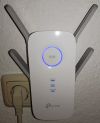
|
TP-Link 2021 |
85€ UVP | 128 | 16(v1) 8(v2) |
880/MediaTek MT7621AT DualCore SMT (2Cores/4Threads) |
4x4:4@2,4Ghz 4x4:4@5Ghz ac |
v1.0[6935364094348] v2.1[] |
1 LAN (1Gbit), 4 feste kombinierte Antennen, LED-Ausschalter | Einfach 192.168.0.254/24(LAN) (per Webinterface) (ab 8.1.7) |
Original (100-240V0.4A) 4,6W(Leerlauf) |
Xiaomi Redmi Router AC2100 
|
Xiaomi 2019/11 |
ab 45€ (neu) | 128 | 128 | 880/MediaTek MT7621AT DualCore SMT (2Cores/4Threads) |
2x2:2@2,4Ghz 4x4:4@5Ghz ac |
. | 3 LAN (1Gbit): 1 WAN, 2,4Ghz und 5Ghz (AC) WLAN, 6 feste Antennen | Anspruchsvoll |
|
D-Link COVR-X1860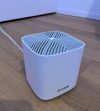
|
D-Link 2023 |
EOL!!! Gebraucht ca. 40€ pro Paar (10/24 LA) | 256 | 128 | 880/MediaTek MT7621AT DualCore SMT (2Cores/4Threads) |
2x2:2@2,4Ghz ax 2x2:2@5Ghz ax |
A1[790069459030] | 1 LAN (1Gbit): 1 WAN, 2,4Ghz (AX) und 5Ghz (AX) WLAN, 4 interne Antennen | Einfach 192.168.0.1 (per LAN/WLAN) Router einrichten COVR-X1860 |
Originalnetzteil 12V/1A(12W) 4,5W(Leerlauf+2xGBLAN) 3,9W(LeerlaufWLAN) |
ZyXEL NWA55AXE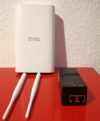
|
ZYXEL 2023 |
120€ UVP 50-80€ eBay |
256 | 128 | 880/MediaTek MT7621AT DualCore SMT (2Cores/4Threads) |
2x2:2@2,4Ghz ax 2x2:2@5Ghz ax |
[] | 1 LAN (1Gbit) POE, 2,4Ghz 4dBi (AX) und 5Ghz (AX) 5 dBi WLAN, 2 externe Antennen, Outdoor (580g mit Antennen) | Einfach 192.168.1.2 (admin/1234) Router einrichten ZyXEL55AXE |
5,1W(Leerlauf1GBPOE) 4,5W(WLAN) PoE (802.3at / Netzteil 48V/0,5A): power draw 16 W |
D-Link DAP-X1860 Range Extender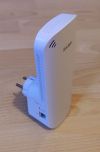
|
D-Link 2023 |
ab 60€ (neu) MM:29€ MM:15€ |
256 | 128 | 880/MediaTek MT7621AT DualCore SMT (2Cores/4Threads) |
2x2:2@2,4Ghz ax 2x2:2@5Ghz ax |
A1[790069457708] | 1 LAN (1Gbit) 2,4Ghz (AX) und 5Ghz (AX) WLAN, 4 interne Antennen | Einfach 192.168.0.50 (per Webinterface) Router einrichten DAP-X1860 |
Originalnetzteil 240V/0,2A 4,1W(Leerlauf+1xGBLAN) 3,8W(LeerlaufWLAN) |
GL-iNet GL-MT1300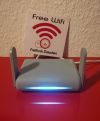
|
GL-iNet 2021 |
$99 UVP | 256 | 32 | 880/MediaTek MT7621AT DualCore SMT (2Cores/4Threads) |
2x2:2@2,4Ghz 2x2:2@5Ghz ac |
v1[6971131380597] | 3 LAN:1 WAN (1Gbit), 2 feste kombinierte Antennen. mSD Card, USB 3.0 (1A) z.B. für LTE-Stick/Smartphones, Tethering möglich | Einfach 192.168.8.1/24(LAN) (per Webinterface) |
Originalnetzteil (15W) 5V/3A USB-C 2,7W(Leerlauf) 3,7W(Vollast CPU) |
TP-Link Archer C6U 
|
TP-Link 2022 |
45€ UVP | 128 | 16 | 880/MediaTek MT7621DAT DualCore SMT (2Cores/4Threads) |
2x2:2@2,4Ghz 2x2:2@5Ghz ac |
v1 | 4 LAN (1Gbit): 1 WAN, 2,4Ghz und 5Ghz (AC) WLAN, 4 feste Antennen, USB 2.0 (z.B. für LTE-Stick/Smartphones, Tethering möglich) |
Einfach 192.168.0.1/24(W+LAN) (per Webinterface) |
Originalnetzteil 12V/1A |
Renkforce WS-WN530HP3-A
|
Renkforce |
40€ UVP (nicht bestellbar) | 128 | 16 | 880/MediaTek MT7621DAT DualCore SMT (2Cores/4Threads) |
2x2:2@2,4Ghz 2x2:2@5Ghz ac |
[4053199007127] | 2 LAN (1Gbit), 1 WAN (passive POE), 2,4Ghz und 5Ghz (AC) WLAN, 4 interne Antennen |
Anspruchsvoll??? 192.168.10.1/24(LAN) TO DO Anleitung`? |
Originalnetzteil 24V/0,6A |
Xiaomi 4A Gigabit Edition 
|
Xiaomi 2018/05 |
30€ UVP 20€ Angebot |
128 | 16 | 880/MediaTek MT7621AT DualCore SMT (2Cores/4Threads) |
2x2:2@2,4Ghz 2x2:2@5Ghz ac |
GbE | 2 LAN (1Gbit): 1 WAN, 2,4Ghz und 5Ghz (AC) WLAN, 4 feste Antennen | Anspruchsvoll 192.168.31.1/24(W+LAN) Anleitung: Router einrichten Xiaomi |
Originalnetzteil 3W(Leerlauf) 4,2W(Vollast) |
TP-Link Archer C6 v3 
|
TP-Link 2022 |
40€ UVP | 128 | 16 | 880/MediaTek MT7621DAT DualCore SMT (2Cores/4Threads) |
2x2:2@2,4Ghz 2x2:2@5Ghz ac |
v3.2[6935364084XXX] | 4 LAN (1Gbit): 1 WAN, 2,4Ghz und 5Ghz (AC) WLAN, 4 feste Antennen |
Einfach 192.168.0.1/24(W+LAN) |
Originalnetzteil 12V/1A |
YouHua WR1200JS
|
YouHua 2017/09 |
35€ (gebraucht) | 128 | 16 | 880/MediaTek MT7621AT DualCore SMT (2Cores/4Threads) |
2x2:2@2,4Ghz 2x2:2@5Ghz ac | 4 LAN (1Gbit): 1 WAN, 2,4Ghz und 5Ghz (AC) WLAN, USB (z.B. für LTE-Stick/Smartphones, Tethering möglich) , 2 feste kombinierte Antennen | Einfach 192.168.1.1 |
Originalnetzteil WLAN:3,5W WAN:(100MBit):3,6W WAN(100MBit) +LAN(1GBit):3,9W | |
| FRITZ!Repeater 1200 2019/12 
|
AVM | 70 € | 256 | 128 | 717/Qualcomm Atheros IPQ4019 ARM7 32Bit QuadCore (4Cores/4Threads) |
2x2:2@2,4Ghz 2x2:2@5Ghz ac |
Repeater, 2 interne Antennen * Router einrichten AVM |
Kompliziert |
WLAN:?W | |
FRITZ!Box 7520 FRITZ!Box 7530 
|
AVM | 99 € | 256 | 128 | 716/Qualcomm Atheros IPQ4019 ARM7 32Bit QuadCore (4Cores/4Threads) |
2x2:2@2,4Ghz 2x2:2@5Ghz ac |
VDSL-Router, 2 interne Antennen * Router einrichten AVM, x4 GB LAN, USB 3.0 |
Kompliziert |
NT: 12V/1,5A |
Gute Geräte
Mindestanforderungen:
- 128 MB Arbeitsspeicher
- 16 MB Flashspeicher
- 80 Mhz 5Ghz AC Unterstützung und MIMO
| Geräte-Name | Hersteller / Release | Preis | RAM in MB | Flash ROM in MB | Mhz/SoC (CPU-Leistung) |
MIMO 1x1:1 | Version[EAN] (tested) | Beschreibung | Schwierigkeitsgrad LAN-Adresse OriginalFW (Nutzername Password) |
Wirkleistung |
|---|---|---|---|---|---|---|---|---|---|---|
Strong Router 1200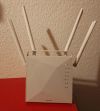
|
Strong TV 2016/06 |
35€(gebraucht) 69€(neu) | 128 | 16 | 880/MediaTek [MT7621AT läuft als ST] SingleCore SMT (1Core/2Threads) |
2x2:2@2,4Ghz 2x2:2@5Ghz ac | 4 LAN (1Gbit): 1 WAN, 2,4Ghz und 5Ghz (AC) WLAN, USB 3.0 (z.B. für LTE-Stick/Smartphones, Tethering möglich) , 4 feste Antennen, µSD Slot | Einfach 192.168.1.1 (Rückseite) |
||
Netgear R6220 Vorsicht einige Geräte zeigen Wifi 2.4Ghz Ausfälle |
NETGEAR 2014/12 |
35€(gebraucht) 60€(neu) | 128 | 128 | 880/MediaTek MT7621ST SingleCore SMT (1Core/2Threads) |
2x2:2@2,4Ghz 2x2:2@5Ghz ac | 4 LAN (1Gbit): 1 WAN, 2,4Ghz und 5Ghz (AC) WLAN, USB (z.B. für LTE-Stick/Smartphones, Tethering möglich) , 4 feste Antennen in 2 Gehäusen | Einfach 192.168.1.1 (admin password) |
WLAN:4,0W | |
Netgear WAC104
|
NETGEAR | 20€(gebraucht) | 128 | 128 | 880/MediaTek MT7621ST SingleCore SMT (1Core/2Threads) |
2x2:2@2,4Ghz 2x2:2@5Ghz ac | 3 LAN (1Gbit): 1 WAN, 2,4Ghz und 5Ghz (AC) WLAN, 4 feste Antennen in 2 Gehäusen | Einfach 192.168.1.1 (admin password) |
WLAN:?W | |
TP-Link Archer C6 v2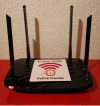
|
TP-Link |
EOL; | 128 | 8 | 775/Qualcomm Atheros 9563 | 2x2:2@2,4Ghz 2x2:2@5Ghz ac |
v2[] | 4 LAN (1Gbit): 1 WAN, 4 feste Antennen | Einfach 192.168.0.1 |
12V/1A |
Ubiquiti UniFi AC Mesh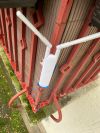
|
Ubiquiti | 120 € | 128 | 16 | 775/Qualcomm Atheros 9563 | 2x2:2@2,4Ghz 2x2:2@5Ghz ac |
x | 1 LAN, Outdoor | ||
TP-Link Archer C7 AC1750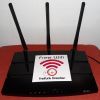
|
TP-Link 2016/11v4 |
60€ | 128 | 8 (v1) 16 (v2-v5) |
720/Qualcomm Atheros 9558 (v1-3) 775/9558 (v4) 750/9558 (v5) |
3x3:3@2,4GhzINT (v1-3) 3x3:3@5GhzEXT ac (v1-3) 3x3:3@2,4GhzEXT (v4-5) 3x3:3@5GhzEXT ac (v4-5) |
v1, v2, v3, v4, v5 | 4 LAN (1Gbit): 1 WAN, 3 abnehmbare Dual Antennen ab Version 4, Intere 2,4 Ghz Antennen Version 1-3, v1 kein 5Ghz | Einfach 192.168.0.1 |
|
Netgear R6100
|
NETGEAR 2013/06 |
15€-20€ | 128MB | 128MB | 560/Qualcomm Atheros 9344 | 2x2:2@2,4Ghz 2x2:2@5Ghz ac | 4 LAN (100M): 1 WAN, 2,4Ghz und 5Ghz (AC) WLAN | Einfach 192.168.1.1 |
WLAN:3,2W |
Einsteiger Geräte
Mindestanforderungen:
- 128 MB Arbeitsspeicher
- 16 MB Flashspeicher
| Geräte-Name | Hersteller / Release | Preis | RAM in MB | Flash ROM in MB | Mhz/SoC (CPU-Leistung) |
MIMO 1x1:1 | Version[EAN] (tested) | Beschreibung | Schwierigkeitsgrad LAN-Adresse OriginalFW (Nutzername Password) |
Wirkleistung |
|---|---|---|---|---|---|---|---|---|---|---|
FRITZ!Box 4020 
|
AVM | 30-49 € | 128 | 16 | 750/Qualcomm Atheros 9561 | 3x3:3 | Fritzbox, 3 interne Antennen, USB Anschluss (USB wird nicht von OpenWrt unterstützt) * Router einrichten AVM |
Kompliziert 192.168.178.1 (LAN) |
WLAN:?W | |
GL-iNet GL-AR750
|
GL-iNet |
60€ | 128 | 16 | 650/Qualcomm Atheros 9531 | 2x2:2@2,4Ghz 1x1:1@5Ghz ac | 2 LAN (100M): 1 WAN, 2,4Ghz und 5Ghz (AC) WLAN, MicroSD, 2.0 USB, optional POE 802.3af | Einfach |
<6W | |
Ubiquiti UniFi AP LT (Lite), Ubiquiti UniFi AP PRO
|
Ubiquiti < | 65€ | 128(Pro) | 16(Pro) | 560/Qualcomm Atheros 9344 | 3x3:3@2,4Ghz 2x2:2@5Ghz an |
Der Ubiquiti UniFi AP hat einen LAN Anschluss, die Pro Variante hat 2, Stromversorgung über POE * Router einrichten |
Kompliziert |
WLAN+LAN:3,8W | |
Joy-IT OR750i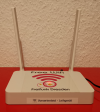
|
Joy-IT | 40 € | 128 | 16 | 650/Qualcomm Atheros 9533 | 2x2:2@2,4Ghz 1x1:1@5Ghz ac kein 5GHz Mesh |
v1 | 2x2,4Ghz ext. Antennen, 1x5Ghz(A) intern, 1xWAN 3x LAN (100MBit/s) | Einfach 10.123.123.1 DHCP (LAN&WAN) |
Netzteil 12V 600mA WLAN:2,6W |
GL-AR300M ext
|
GL.iNet 2016/09 |
35€ | 128 | 128 NAND/16 | 650/Qualcomm Atheros 9531 | 2x2:2 | vx | Reiseminirouter mit Stromversorgung per Micro-USB, 2 externe abnehmbare Antennen, USB 2.0 Anschluss (z.B. für LTE-Stick/Smartphones, Tethering möglich) * Router einrichten GL-iNet, 1xWAN 1xLAN |
192.168.8.1 (WLAN) | max. 5V/2A |
GL-AR300M-Lite
|
GL.iNet 2016/09 |
20€ | 128 | 16 | 650/Qualcomm Atheros 9531 | 2x2:2 | vx | Reiseminirouter mit Stromversorgung per Micro-USB, 2 interne Antennen, USB Anschluss (z.B. für LTE-Stick/Smartphones, Tethering möglich) * Router einrichten GL-iNet |
Einfach 192.168.8.1 (WLAN) |
WLAN:1W WAN:1,3W |
GL-iNet GL-MT300N-V2
|
GL-iNet |
35€ | 128 | 16 | 580/MediaTek MT7628AN | 2x2:2@2,4Ghz | 1 LAN (100M): 1 WAN, 2,4Ghz WLAN Stronversorgung über Micro | USB, 5V/2A (<2.75W) | ||
FRITZ!Box 7412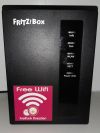
|
AVM 2014/10 |
ab 15 € | 128 | 128 | 500/intel Lantiq XWAY VRX220 (1Core/2Threads) | 2x2:2 | Fritzbox, 2 interne Antennen, nur ein LAN Port) * Router einrichten AVM |
Anspruchsvoll 192.168.178.1 (LAN) |
WLAN:3,5W NT:12V/1A | |
FRITZ!Box 3370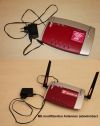
|
AVM 2011/02 |
ab 15 € | 128 | 128 | 500/intel Lantiq XWAY VRX220 (1Core/2Threads) | 2x2:2 | Micron & Hynix Variante | Fritzbox, 2 interne Antennen, durch leichte Modifikation abnehmbare Antennen möglich * Router einrichten AVM |
Anspruchsvoll 192.168.178.1 (LAN) |
WLAN:5,0W |
FRITZ!Box 7360 SL
|
AVM 2012/03 |
ab 15 € | 128 | 16 | 500/intel Lantiq XWAY VRX220 (1Core/2Threads) | 2x2:2 | Fritzbox, 2 interne Antennen * Router einrichten AVM |
192.168.178.1 (LAN) | WLAN:5,0W | |
FRITZ!Box 7360 V2
|
AVM 2012/03 |
ab 15 € | 128 | 32 | 500/intel Lantiq XWAY VRX220 (1Core/2Threads) | 2x2:2 | Fritzbox, 2 interne Antennen 100M-Ports: 2 Gbit-Ports: 2 * Router einrichten AVM |
Anspruchsvoll 192.168.178.1 (LAN) |
||
FRITZ!Box 7362 SL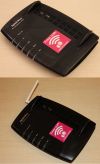
|
AVM 2013/06 |
ab 15 € | 128 | 128 | 500/intel Lantiq XWAY VRX220 (1Core/2Threads) | 2x2:2 | Fritzbox, 2 interne Antennen, 42 (2xGB, 2x100MB) LAN Ports, 2xUSB2.0, durch leichte Modifikation eine abnehmbare Antenne möglich * Router einrichten AVM |
Kompliziert 192.168.178.1 (LAN) |
WLAN:5,0W NT:12V1,5A | |
FRITZ!Box 7430  |
AVM |
ab € | 128 | 128 | 500/intel Lantiq XWAY VRX220 (1Core/2Threads) | 3x3:3 | 4xLAN 100MB, USB2.0, durch leichte Modifikation eine abnehmbare Antenne möglich |
Anspruchsvoll | WLAN:?W |
Bedingt empfohlen
Mindestanforderungen:
- 64 MB Arbeitsspeicher
- 8 MB Flashspeicher
| Geräte-Name | Hersteller / Release | Preis | RAM in MB | Flash ROM in MB | Mhz/SoC (CPU-Leistung) |
MIMO 1x1:1 | Version[EAN] (tested) | Beschreibung | Schwierigkeitsgrad LAN-Adresse OriginalFW (Nutzername Password) |
Wirkleistung |
|---|---|---|---|---|---|---|---|---|---|---|
TP-Link Archer C60 AC1350
|
TP-Link |
EOL; | 64 | 8 | 775/Qualcomm Atheros 9561 | 3x3:3@2,4Ghz 2x2:2@5Ghz ac |
v1, v2 v3 | 4 LAN (1Gbit): 1 WAN, 5 feste Antennen | Einfach (v1) 192.168.0.1 |
12V/1A |
TL-WR1043N
|
TP-Link 2016/11 |
35€ | 64 | 16 | 775/Qualcomm Atheros 9563 | 3x3:3 | !v5 | 4 LAN (1Gbit): 1 WAN, 3 feste 5dBi Antennen | Einfach 192.168.0.1 |
|
TL-WR1043ND
|
TP-Link 2015/07v4 201603v3 |
50€ EOL | 64 | 16(v4) 8(v2-v3) |
750/9563(v4) 720/9558(v3) 720/Qualcomm Atheros 9558(v2) |
3x3:3 | v2, v3, v4 | 4 LAN (1Gbit): 1 WAN, USB (z.B. für LTE-Stick/Smartphones, Tethering möglich), 3 abnehmbare 5dBi Antennen, Gigabit Ports | Einfach 192.168.0.1 |
WLAN:2,5W WAN:3,2W WAN+LAN:3,6W |
TL-WDR4300
|
TP-Link 2012/07 |
70€ | 128 | 8 | 560/Qualcomm Atheros 9344 | 2x2:2@2,4Ghz 3x3:3@5Ghz an | v1 | 4 LAN (1Gbit): 1 WAN, 2xUSB (z.B. für LTE-Stick/Smartphones, Tethering möglich) Anschlüsse, 3 abnehmbare Dual Antennen 2dBi@2.4Ghz / 3dBi@5Ghz(A) | Einfach 192.168.0.1 |
WLAN:4,0W LAN:4,4W |
TL-WDR3600
|
TP-Link 2012/10 |
55€ | 128 | 8 | 560/Qualcomm Atheros 9344(v1) | 2x2:2@2,4Ghz 2x2:2@5Ghz an | v1 | 4 LAN (1Gbit): 1 WAN, 2xUSB (z.B. für LTE-Stick/Smartphones, Tethering möglich) Anschlüsse, 2 abnehmbare Dual Antennen 2dBi@2.4Ghz / 3dBi@5Ghz(A) | Einfach 192.168.0.1 |
|
Ubiquiti UniFi AP LT (Lite), Ubiquiti UniFi AP PRO
|
Ubiquiti < | 65€ | 64(LT) 128(Pro) |
8(LT) 16(Pro) |
560/Qualcomm Atheros 9344 | 3x3:3@2,4Ghz 2x2:2@5Ghz an |
Der Ubiquiti UniFi AP hat einen LAN Anschluss, die Pro Variante hat 2, Stromversorgung über POE * Router einrichten |
Kompliziert |
WLAN+LAN:3,8W | |
Netgear R6120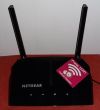 2017/03 |
NETGEAR 2017/03 |
15€-20€ | 64 | 16 | 580/MediaTek MT7628A | 2x2:2@2,4Ghz 2x2:2@5Ghz ac | 4 LAN (100M): 1 WAN, 2,4Ghz und 5Ghz (AC) WLAN, USB2.0 (z.B. für LTE-Stick/Smartphones, Tethering möglich) | Einfach 192.168.1.1 |
WLAN:2,5W LAN:2,7W | |
| Xiaomi Mi Router 4A |
Xiaomi 2021/07FCC |
15€-20€ | 64 | 16 | 580/MediaTek MT7628AN | 2x2:2@2,4Ghz 2x2:2@5Ghz ac | 2 LAN (100M): 1 WAN, 2,4Ghz und 5Ghz (AC) WLAN | |||
NanoStation loco M2 XW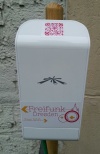 ACHTUNG: HINWEIS unter Beschreibung beachten!* |
Ubiquiti | 50€ | 64 | 8 | 535/Qualcomm Atheros 9342 | 2x2:2 | XW | 2,4 GHz Flächenfunk, 8,5dBi MIMO, Outdoor, 60° Öffnungswinkel, Power over Ethernet + Injector, doppelter Arbeitspeicher der XM Version mit 37% schneller getaktetem SOC und halbiertem Stromverbrauch * Router einrichten Nanostation |
Anspruchsvoll 192.168.1.20 (kein DHCP) |
WLAN:2,0W LAN:2,3W |
CPE210 v1.1 
|
TP-Link | 40-50€
|
64 | 8 | 560/9344 | 2x2:2 | v1 | Outdoor Richtfunk, 2x2 MIMO 9dbi Antennen im wetterfestem Gehäuse, RJ45 WAN, LAN und RP-SMA Antennten Anschluss | ||
CF-E314N v2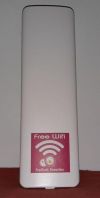
|
Comfast E314N | 47 € | 64 | 8 | 650/Qualcomm Atheros QCA9531 | v2 | 2 Ports 1 LAN : 1 WAN, leider keine schwenkbare Halterung, 48 Volt POE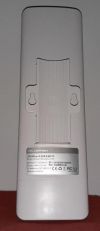 * Router einrichten Comfast |
192.168.10.1 | ||
CF-E130N v2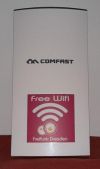
|
Comfast E130N | 25 € | 64 | 8 | 650/Qualcomm Atheros QCA9531 | v2 | nur LAN Port, leider keine schwenkbare Halterung, 9-24 Volt POE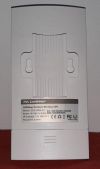 * Router einrichten Comfast |
192.168.10.1 | ||
CF-E110N v2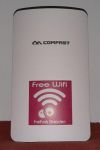
|
Comfast E110N | 33 € | 64 | 8 | 650/Qualcomm Atheros QCA9531 | v2 | 2 Ports 1 LAN : 1 WAN, mit schwenkbarer Halterung, 9-24 Volt POE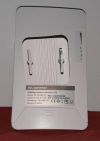 * Router einrichten Comfast |
192.168.10.1 | ||
FRITZ!WLAN Repeater 450E |
AVM | ? € | 64 | 16 | 560/Qualcomm Atheros 9556 | 3x3:3 | Repeater, 3 interne Antennen * Router einrichten AVM |
Anspruchsvoll 192.168.178.1 (LAN) |
WLAN:?W | |
Xiaomi Mi Router 4C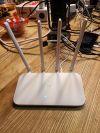
|
Xiaomi 2021/04FCC |
9€ | 64 | 16 | 575/MediaTek MT7628DAN | 2x2:2@2,4Ghz | 2 LAN (100M): 1 WAN, Nur 2,4Ghz WLAN | Anspruchsvoll | ||
TL-WR841N 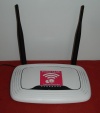
|
TP-Link | 5€ | 64 | 8 | 560/MediaTek MT7628N | 2x2:2 | v13 | Mit nicht abnehmbaren 5dBi Antennen ausgestattet. | 192.168.0.1 Einfach |
|
| GL.iNet GL-MiFi |
GL.iNet | ? € | 64 | 16 | 400/Qualcomm Atheros 9331 | 2x2:2 | Router mit eingebautem LTE Modem und Akku, 1xUSB 2.0, 1xWAN 1xLAN, 2 interne Antennen |
|||
| FRITZ!WLAN Repeater 300E |
AVM | ? € | 64 | 16 | 400/Qualcomm Atheros 7242 | 2x2:2 | Repeater, 2 interne Antennen * Router einrichten AVM |
192.168.178.1 (LAN) | WLAN:?W | |
FRITZ!Box 7312 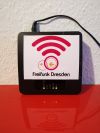 |
AVM |
ab € | 64 | 16 | 393/intel Lantiq XWAY ARX188 (1Cores/1Thread) | 2x2:2 | Fritzbox, 2 interne Antennen, 1 LAN Port | Anspruchsvoll | WLAN:2,5W NT:6V/1,4A | |
FRITZ!Box 7320  |
AVM |
ab € | 64 | 16 | 393/intel Lantiq XWAY ARX188 (1Core/1Thread) | 2x2:2 | Fritzbox, 2 interne Antennen, x2 GB LAN Port, USB2.0 (z.B. für LTE-Stick/Smartphones, Tethering möglich) | Anspruchsvoll | NT:12V/1A | |
FRITZ!Box 7330  FRITZ!Box 7330SL 
|
AVM |
ab € | 64 | 16 | 393/intel Lantiq XWAY ARX188 (1Core/1Thread) | 2x2:2 | Fritzbox, 2 interne Antennen, x2 GB LAN Port, USB2.0 (z.B. für LTE-Stick/Smartphones, Tethering möglich), (LAN2 nicht unterstützt, Firmware von FRITZ!Box 7320 verwenden!) | Anspruchsvoll | NT:12V/1A |
*) Version teilweise im Handel erhältlich. Wird noch nicht unterstützt. Falsches aufspielen der Firmware macht das Gerät unbrauchbar!
2) Gemessen mit Voltcraft Energie Logger 4000
Alte Router
Folgende Router wurden ebenfalls getestet und werden "unterstützt", aber:
Warnung!
- Seit OpenWrt 19 aus dem Jahre 2020 werden diese Geräte nicht mehr durch OpenWrt unterstützt, d.h. auch keine Kernel -Sicherheitsaktualisierungen, da:
- nur 32 MB Arbeitsspeicher
- nur 4 MB Flashspeicher
- Von Neuanschaffung wird dringend abgeraten!
- Ebenso abgeraten ist der Einsatz als Knoten mit direkter Internetverbindung
- Als Meshknoten im 2,4 Ghz Band können diese alten Router aber dennoch brauchbare Dienste leisten.
| Geräte-Name | Hersteller | Preis | RAM | Flash ROM | Mhz/SoC (CPU-Leistung) |
MIMO 1x1:1 | Version (tested) | Beschreibung | LAN-Adresse OriginalFW | Wirkleistung |
|---|---|---|---|---|---|---|---|---|---|---|
TL-WA801ND 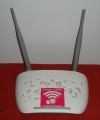
|
TP-Link | -; | 32 | 4 | 560/9533(v3) 535/9341(v2) 400/7240(v1) |
2x2:2 | v1, v2, v3, (!v5') | Accespoint besitzt abnehmbare zwei Antennen, Stromversorgung über POE möglich. *v5 Die Version wird nicht unterstützt, Freifunk ist nicht möglich, da der verbaute MediaTek SoC unser Mesh nicht unterstützt. | 192.168.0.254 | |
TL-WR802N 
|
TP-Link | 10-20€ | 32 | 4 | 510/9533(v1) | 2x2:2 | v1, (!v2') | Router besitzt zwei Antennen, Stromversorgung über Micro-USB-Port *v2 Die Version wird noch nicht unterstützt. | ? | |
TL-WR841N 
|
TP-Link | <v8:EOL 18-25€ | 32 | 4 | 650/9533(v12) 650/9533(v11) 650/9533(v10) 550/9533(v9) 535/9341(v8) 400/7241(v7) 400/7240(v5) |
2x2:2 | v3, v5, v7-v12, (!v14*), | Im Unterschied zum Modell mit der Endung ND mit nicht abnehmbaren 5dBi Antennen ausgestattet. *v14 ist erhältlich, Freifunk ist aber nicht möglich, da der verbaute MediaTek SoC unser Mesh nicht unterstützt. | 192.168.0.1 | v8:WLAN:1,9W v8:LAN:2,2W v8:WAN+LAN:2,5W v10:WLAN:1,4W v10:LAN:1,7W v10:WAN+LAN:2,0W v11:WLAN:1,3W |
TL-WR841ND 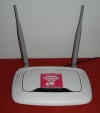
|
TP-Link | <v8:EOL 23-30€ | 32 | 4 | 650/9533(v11) 650/9533(v10) 550/9533(v9) 535/9341(v8) 400/7241(v7) 400/7240(v5) |
2x2:2 | v3, v5, v7-v11 | D steht für detachable, der Router besitzt also abnehmbare 5dBi Antennen. | 192.168.0.1 | v8:WLAN:1,9W v8:LAN:2,2W v8:WAN+LAN:2,5W v10:WLAN:1,4W v10:LAN:1,7W v10:WAN+LAN:2,0W v11:WLAN:1,3W |
TL-WR842N 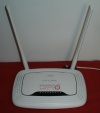
|
TP-Link | <v2:EOL | 32 | 16 | 650/9531 | 2x2:2 | v3 | Router besitzt zwei weiße 5dBi Antennen, USB Port, viel mehr Flash-ROM | 192.168.0.1 | WAN+LAN: 4,4W? |
TL-WR842ND 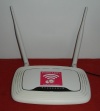
|
TP-Link | <v2:EOL | 32 | 8 | 400/7241(v1) | 2x2:2 | v1, v2 | ND Router besitzt zwei weiße abnehmbare 5dBi Antennen, USB Port, mehr Flash-ROM | 192.168.0.1 | WAN+LAN: 4,4W |
| TL-WR1043ND 100px |
TP-Link | [1] | 32 | 8 | 400/9132 | 2x2:3 | v1 | Router besitzt drei abnehmbare 5dBi Antennen und USB | 192.168.0.1 | WAN+LAN: xW |
TL-WA850RE 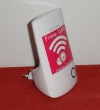
|
TP-Link | ab 15€ | 32 | 4 | 500/9341 | 2x2:2 | v1.21 | Repeater besitzt 1 LAN Anschluss, gut geeignet für MESH im Haus oder Wohnung aber auch als einzel Gerät geeignet | 192.168.0.254 | 3W |
TL-WA860RE 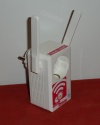
|
TP-Link | ab 15€ | 32 | 4 | 500/9341 | 2x2:2 | v1, !v5 | Repeater besitzt 1 LAN Anschluss, gut geeignet für MESH im Haus oder Wohnung aber auch als einzel Gerät geeignet, Vorteil hier Steckdose kann weiter genutzt werden | 192.168.0.254 | 3W |
TL-WA901ND 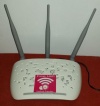
|
TP-Link | EOL | 32 | 4 | 750/9343(v5) 750/9343(v4) 533/9341(v3) 400/9132(v2) 400/7240(v1) |
3x3:3(>=v4) 3x3:2(<=v3) |
v1, v2, v3, v4, v5 | Accesspoint, 3x5dBi Antennen(v4), 30m passiv POE / 100m 48V POE, nur 1x LAN Port kein extra WAN Port kein Switch | 192.168.0.254 | |
TL-WR940N 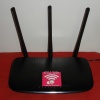
|
TP-Link | ab 15€ | 32 | 4 | 750/9343(>=v3) 535/9341(v2) 400/7240(v1) |
3x3:3(>=v3) 3x3:2(<=v2) |
v1, v2, v3, v4(EU), v5, v6, 6.1(EU) | 3 nicht abnehmbare Antennen, WAN und 4xLAN-Anschluss, v3 ist identisch zum 941N v6 daher diese Firmware verwenden (Im Menü unter Firmware drauf achten das WR940v3/WR941v6 steht.) Besonderheit: WR940Nv1=Firmware>>WR941NDv4 |
192.168.0.1 | |
TL-WR941ND 
|
TP-Link | <v6:EOL ab 15€ | 32 | 4 | 750/9343(v6) 535/9341(v5) 400/7240(v4) 400/9132(<=v3) |
3x3:3(v6) 3x3:2(<=v5) |
v2, v3,v4, v5, v6 | 3 abnehmbare 3dBi (v6: 5dBi) Antennen, WAN und 4xLAN-Anschluss | 192.168.0.1 | v4:LAN:4,1W v4:WAN+LAN:4,4W v5:WLAN:1,9W v5:LAN:2,2W v5:WAN+LAN:2,5W |
NanoStation loco M2 XM  !ACHTUNG HINWEIS unter Beschreibung beachten!* |
Ubiquiti | 50€ | 32 | 8 | 390/7241 | 2x2:2 | XM | !Bitte die Hinweise im folgendem Link beachten: Router einrichten Nanostation 2,4 GHz Flächenfunk, 8,5dBi MIMO, Outdoor, 60° Öffnungswinkel, Power over Ethernet + Injector | 192.168.1.20 (kein DHCP) | WLAN:3,5W LAN:3,8W |
| Rocket M2 !ACHTUNG HINWEIS unter Beschreibung beachten!* 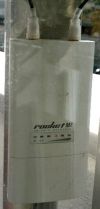
|
Ubiquiti | 80€ | 64 | 2x2:2 | Ein direktes aufspielen alternativer Firmware wie OpenWrt und somit auch Freifunk verhindert Ubiquiti mit der eigenen Firmware (Ab Version AirOS5.6), das Ubiquiti Gerät wird danach unbrauchbar und ist ohne größeren technischem Aufwand (wenn überhaupt/nicht) mehr zu retten! Möglich soll es sein, in dem man VORHER ein Downgrade auf AirOS5.5 vornimmt und ERST DANACH auf alternative Firmware updatet. Bis zur Klärung des Sachverhaltes wird dringend davon abgeraten, Freifunk und alternative Firmware auf Ubiquiti-Geräten mit AirOS Version größer 5.5 aufzuspielen.* 2 Antennenanschlüsse, 2,4 GHz Outdoor, benötigt Antennen, Power over Ethernet + Injector | |||||
| Nanostation NSM2 !ACHTUNG HINWEIS unter Beschreibung beachten!* 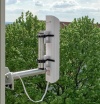
|
Ubiquiti | ca 80€ | 32 | 8 | 390/7241 | 2x2:2 | XM | !Bitte die Hinweise im folgendem Link beachten: Router einrichten Nanostation 2,4 GHz Richtfunk, 11dBi MIMO, Outdoor, 60° Öffnungswinkel, Power over Ethernet + Injector, Zwei LAN Anschlüsse | 192.168.1.20 (kein DHCP) |
*) Version teilweise im Handel erhältlich. Wird noch nicht unterstützt. Falsches aufspielen der Firmware macht das Gerät unbrauchbar! 2) Gemessen mit Voltcraft Energie Logger 4000
Vorsintflutliche Geräte
Kurz bevor die Hölle zufriert, bereits schon alle Stricke gerissen sind und die Apokalypse kurz bevor steht, dann "können" diese Geräte zum Einsatz kommen.
Folgende Geräte haben zu wenig Speicher und nur eine Antenne im 2,4 Ghz Bereich, einen wirklichen Gefallen tut ihr damit Niemanden. Der Einsatz solcher Geräte in einem Mesh, macht jenes eher kaputt, als es zu erweitern. ;)
| Geräte-Name | Hersteller | Preis | RAM | Flash ROM | Mhz/SoC (CPU-Leistung) |
MIMO 1x1:1 | Version (tested) | Beschreibung | LAN-Adresse OriginalFW | Wirkleistung |
|---|---|---|---|---|---|---|---|---|---|---|
| TL-WA701ND |
TP-Link | EOL | 32 | 4 | 400/9330 | 1 | v2 | Accesspoint: Power over Ethernet + 9V Injector bis 30 Meter, mit zusätzlichem 48V-PoE Injector bis 100m, 1xLAN Anschluss, Router besitzt eine abnehmbare 5dBi Antenne | ||
TL-WR710N 
|
TP-Link | ca. 15€ | 32 | 8 | 400/9331 | 1 | v1 (EU*), v2 | Reiserouter, 1x interne Antenne, WAN und LAN-Anschluss, USB Port | 192.168.0.254 | WLAN:0,6W LAN:1,0W WAN+LAN:1,3W |
TL-WR741ND 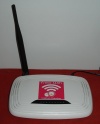
|
TP-Link | EOL | 32 | 4 | 400/9331(v5) 400/9331(v4) 350/7240(v2) |
1 | v1, v2, v4, v5 | Modell mit der Endung ND hat eine abnehmbare 5dBi Antenne. | 192.168.0.1 | |
TL-WR740N 
|
TP-Link | EOL | 32 | 4 | 400/9331(v4) | 1 | v4 | Modell mit der Endung N hat eine 5dBi Antenne. | 192.168.0.1 | |
TL-WA7210 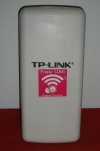
|
TP-Link | ab 23€ | 32 | 4 | 1x1:1 | v2 | Interne dualpolarisierte 12dBi-Richtantenne, Sendeleistung bis zu 500mW für große Übertragungsdistanzen, Externer Reverse-SMA-Anschluss, Erdungsanschluss | 192.168.0.254 | ||
TL-MR3020 
|
TP-Link | 30€ | 32 | 4 | 400/9331 | 1 | v1 | Reiseminirouter mit Stromversorgung per Mini-USB, interne Antenne, USB Anschluss (z.b. für UMTS/LTE-Stick, jene werden allerdings nicht von der Freifunksoftware unterstützt) | 192.168.0.254 | |
AirRouter AR !ACHTUNG HINWEIS unter Beschreibung beachten!* |
Ubiquiti | ca 40€ | 32 | 8 | 390/7241 | 1 | v1 | Ein direktes aufspielen alternativer Firmware wie OpenWrt und somit auch Freifunk verhindert Ubiquiti mit der eigenen Firmware (Ab Version AirOS5.6), das Ubiquiti Gerät wird danach unbrauchbar und ist ohne größeren technischem Aufwand (wenn überhaupt/nicht) mehr zu retten! Möglich soll es sein, in dem man VORHER ein Downgrade auf AirOS5.5 vornimmt und ERST DANACH auf alternative Firmware updatet. Bis zur Klärung des Sachverhaltes wird dringend davon abgeraten, Freifunk und alternative Firmware auf Ubiquiti-Geräten mit AirOS Version größer 5.5 aufzuspielen.* kleiner Endverbraucher-Router, Indoor, interne Antenne | 192.168.1.20 | WLAN:3,3W LAN:3,6W WAN+LAN:4,1W |
2) Gemessen mit Voltcraft Energie Logger 4000
Offloader
Offloader stammen noch außer der Zeit, als das "fastd" Protokoll Stand der Freifunkkunst war, in Zeiten von "Wireguard" sind jene fast überflüssig, wenn man einen leistungsstarken Router (siehe oben) als Internetzugangspunkt einsetzt.
| Geräte-Name | Hersteller | Preis | RAM in MB | Flash ROM in MB | CPU (Architektur) | Beschreibung | Idle Verbrauch | Max Verbrauch | WorstCase (+Zubehör) Netzteil | Spannung Toleranz | Temperatur Operation °C | Speedtest nperf.com |
|---|---|---|---|---|---|---|---|---|---|---|---|---|
IGEL H830C 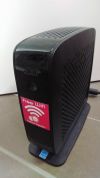
|
IGEL Technology GmbH | ab 50€ gebraucht | variable | variable | Intel(R) Celeron(R) CPU J1900 @ 1.99GHz | Quad-Core | via LAN: >500Mbit/s | |||||
FSC Futro S550 
|
Fujitsu | 35€ | 512-2048 | 512-1024 CompactFlash | AMD Sempron 2100+ Embedded Single-Core 1GHz (x86-AMD64Bit) | ThinClient, 6x USB2.0, 1Gbit LAN | 15 Watt | 20 Watt | 65 Watt = 20V*3,25A | 20 Volt geringe | 15 °C .... 35 °C | via LAN: 77MBit/s 67MBit/s |
Orange Pi R1 
|
Xunlong | 19€ | 256 | 16 (bis zu 32GB microSD) |
Allwinner H2+ 32-bit Cortex-A7 Quardcore (ARMv7) |
Open-source Single-board Computer. 2x 100Mbit/s LAN | 1,6 Watt (WAN+ Mesh onLAN) 2,0 Watt (50Mbit/s) |
2,5 Watt | 10 Watt = 5V*2A | 5 V keine | via LAN: 94 Mbit/s | |
EdgeRouter-X 
|
Ubiquity | 50€ | 256 | 256 | MediaTek MT7621AT Dualcore 2C/4T, 880 MHz (MIPS1004Kc-32Bit) | Router, 5 LAN (1Gbit): 1 POE und 1 POE(Passthrough) | ? Watt | 5 Watt Herstellerangabe | 60 Watt = 24V DC, 2,5 A (POE) | 9 Volt - 30 Volt | -10 bis 45° C (14 bis 113° F) | via LAN: |
FRITZ!Box 4040  Wifi instabil / Nur als Offloader nutzbar (ath10k-instabil)*! |
AVM | 70€ | 256 | 32 | Qualcomm Atheros IPQ4018 628 Mhz Quardcore (ARMv7-32Bit) | Router, 5 LAN (1Gbit), 2,4Ghz und 5Ghz WLAN | ? Watt | 13 Watt Herstellerangabe | 18 Watt = 12V*1,5A | 12 Volt | 0 °C -40 °C | via WiFi: via LAN: |
YouHua WR1200JS 
|
YouHua | 35€ | 128 | 16 | MediaTek MT7621AT Dualcore 2C/4T, 880 MHz (MIPS1004Kc-32Bit) | Router, 4 LAN (1Gbit): 1 WAN, 2,4Ghz(Problemmen) und 5Ghz (AC) WLAN | ? Watt | ? Watt | 18 Watt = 12 VDC, 1.5 A | 12 Volt | via WiFi: via LAN: |
Z-Abteilung
Aus verschiedenen Gründen sind die Geräte noch in Entwicklung, evtl. gibt es schon ein Firmware, die aber noch nicht funktional ist.
| Geräte-Name | Hersteller / Release | Preis | RAM in MB | Flash ROM in MB | Mhz/SoC (CPU-Leistung) |
MIMO 1x1:1 | Version[EAN] (tested) | Beschreibung | Schwierigkeitsgrad LAN-Adresse OriginalFW (Nutzername Password) |
Wirkleistung |
|---|---|---|---|---|---|---|---|---|---|---|
| GL.iNet (GL-MT6000) 
|
GL.iNet 2023/11 |
213€ UVP PR109€+TAX 149€X-MAS23 |
1024 | 8192 | 2000/MediaTek MT7986A ARM A53 64Bit QuadCore (4Cores/4Threads) |
4x4:4@2,4Ghz ax 4x4:4@5Ghz ax |
6971131384205 >=OpenWrt23.05.3 | 1 WAN (2,5Gbit), 1WAN/LAN (2,5GBit), 4xLAN (1GBit), USB 3.0, 2,4Ghz (AX) und 5Ghz (AX) WLAN, 4 feste dual Antennen |
Einfach per GUI 192.168.8.1/24(LAN) |
Originalnetzteil 12V/4A |
| ASUS TUF-AX6000 |
ASUS 2023 |
185€ | 512 | 256 | 2000/MediaTek MT7986AV ARM A53 64Bit QuadCore (4Cores/4Threads) |
4x4:4@2,4Ghz ax 4x4:4@5Ghz ax |
>=OpenWrt23.05.3 | 1 WAN (2,5Gbit), 1LAN/WAN (2,5GBit), 4xLAN (1GBit), USB 3.0, 2,4Ghz (AX) und 5Ghz (AX) WLAN, 6 feste Antennen |
Einfach? 192.168.x.x/24 |
Originalnetzteil 12V/2,5A |
| ASUS TUF-AX4200 |
ASUS 2023 |
130€ | 512 | 256 | 2000/MediaTek MT7986AV ARM A53 64Bit QuadCore (4Cores/4Threads) |
2x2:2@2,4Ghz ax 3x3:3@5Ghz ax |
>=OpenWrt23.05.2 | 1 WAN (2,5Gbit), 4xLAN (1GBit), USB 3.0, 2,4Ghz (AX) und 5Ghz (AX) WLAN, 4 feste Antennen |
Einfach? 192.168.x.x/24 |
Originalnetzteil 12V/2,5A |
| Netgear WAX218 |
Netgear 20xx |
???€ UVP | 512 | 256 | 2200/Qualcomm IPQ8072A ARM A53 64Bit QuadCore (4Cores/4Threads) |
4x4:4@2,4Ghz ax *x*:*@5Ghz ax |
LAN (2,5GBit) POE, 2,4Ghz (AX) und 5Ghz (AX) WLAN, eingebaute Antennen 5dBi |
Einfach? 192.168.x.x/24 |
Originalnetzteil 12V/2,5A (30 Watt) | |
| Netgear WAX220 |
Netgear 20xx |
240€ UVP / Cyberport 130€ | 1024 | 128 | 2000/MediaTek MT7986A ARM A53 64Bit QuadCore (4Cores/4Threads) |
2x2:2@2,4Ghz ax *x*:*@5Ghz ax |
>=OpenWrt23.05.3 | LAN (2,5GBit) POE, 2,4Ghz (AX) und 5Ghz (AX) WLAN, eingebaute Antennen 5dBi |
Einfach? 192.168.x.x/24 | |
| OpenWrt One () |
OpenWrt 2024 |
100€ Aliexpress + Steuern | 1024 | 256 | 1300/MediaTek MT7981B ARM A53 64Bit DualCore (2Cores/2Threads) |
2x2:2@2,4Ghz ax 2x2:2@5Ghz ax ~ 3×3 (2×2 + Zero-wait DFS) |
>=OpenWrt SnapShot | WLAN(2,5GBit) POE, 1x LAN(1GBit), 2,4Ghz (AX) und 5Ghz (AX) WLAN, 3 externe Antennen, USB 2.0, M.2 NVMe SSD<=2242 |
Einfach per GUI 192.168.8.1/24 |
Originalnetzteil 5VV/3A (15 Watt) POE/ USB-C PD <15 Watt |
| GL.iNet Beryl AX (GL-MT3000) |
GL.iNet 20xx |
130€ UVP 80€ (Ostern24) |
512 | 256 | 1300/MediaTek MT7981B ARM A53 64Bit DualCore (2Cores/2Threads) |
2x2:2@2,4Ghz ax 2x2:2@5Ghz ax ~ 3×3 (2×2 + Zero-wait DFS) |
>=OpenWrt23.05.0 | Reiseminirouter mit Stromversorgung per USB-C, WLAN(2,5GBit), 1x LAN(1GBit), 2,4Ghz (AX) und 5Ghz (AX) WLAN, 2 feste externe Antennen, 1 interne Antenne , USB 3.0 z.B. für LTE-Stick/Smartphones, Tethering möglich |
Einfach per GUI 192.168.8.1/24 |
Originalnetzteil 5VV/3A (15 Watt) USB-C Typisch? <8 Watt |
| Cudy TR3000 100px |
Cudy 20xx |
79€ UVP | 512 | 128 | 1300/MediaTek MT7981B ARM A53 64Bit DualCore (2Cores/2Threads) |
2x2:2@2,4Ghz ax 2x2:2@5Ghz ax ~ 3×3 (2×2 + Zero-wait DFS) |
v1 >=OpenWrt23.05.4 | Reiseminirouter mit Stromversorgung per USB-C, WLAN(2,5GBit), 1x LAN(1GBit), 2,4Ghz (AX) und 5Ghz (AX) WLAN, 2 feste externe Antennen, 1 interne Antenne , USB 3.0 z.B. für LTE-Stick/Smartphones, Tethering möglich |
Einfach per GUI und OpenWrt vom Hersteller 192.168.10.1/24 |
Originalnetzteil 5V/3A (15 Watt) Typisch? 5 Watt |
Cudy WR3000 
|
Cudy 20xx |
49€ UVP | 256 | 16 | 1300/MediaTek MT7981B ARM A53 64Bit DualCore (2Cores/2Threads) |
2x2:2@2,4Ghz ax 2x2:2@5Ghz ax |
v1 >=OpenWrt23.05.0 | WLAN(1GBit), 3x LAN(1GBit), 2,4Ghz (AX) und 5Ghz (AX) WLAN, 4 fest externe Antennen 5dBi |
Einfach per GUI und OpenWrt vom Hersteller 192.168.10.1/24 |
Originalnetzteil 12V/1A (15 Watt) Typisch? 5 Watt |
| Cudy RE3000 |
Cudy 20xx |
49€ UVP | 256 | 16 | 1300/MediaTek MT7981B ARM A53 64Bit DualCore (2Cores/2Threads) |
2x2:2@2,4Ghz ax 2x3:2@5Ghz ax |
v1 >=OpenWrt23.05.3 | 1x W?LAN(1GBit), 2,4Ghz (AX) und 5Ghz (AX) WLAN, 2 fest externe Antennen, 1 interne Antenne |
Einfach per GUI und OpenWrt vom Hersteller 192.168.10.254/24 |
Steckdosenrouter Eurostecker Typisch? 5? Watt |
Linksys MR8300 (Dallas) AC2200  5 Ghz Unterstützung in Arbeit |
Linksys | $199 30 &euro (gebraucht) |
512 | 256 | 0717/Qualcomm Atheros IPQ4019+QCA9888 ARM7 32Bit QuadCore (4Cores/4Threads) |
2x2:2@2,4Ghz 2x2:2@5Ghz ac (indoor ch64-) 2x2:2@5Ghz ac (ch100+) |
Kippschalter, 4 LAN (1Gbit): 1 WAN, 2,4Ghz und 5Ghz (AC) WLAN, USB 3.0 (z.B. für LTE-Stick/Smartphones, Tethering möglich) , 4 externe Antennen (6 Antennen 2x5Ghz) | Einfach 192.168.1.1 (Dual Flash) TO DO Anleitung |
WLAN:?W |
noch einsortieren
| Geräte-Name | Hersteller | Preis | RAM | Flash ROM | CPU (Architektur) | Beschreibung | Idle Verbrauch | Max Verbrauch | WorstCase (+Zubehör) Netzteil | Spannung Toleranz | Temperatur Operation °C | Speedtest nperf.com |
|---|---|---|---|---|---|---|---|---|---|---|---|---|
| Aerohive AP-330 | Aerohive AP-330 | RAM 256MB | Flash 64MB | Freescale P1020E Dial Core 533MHz | 2x1Gbit LAN | 12V (2A) | via WiFi: via LAN: | |||||
| Aerohive AP-121 | Aerohive AP-121 | RAM 128MB | Flash 128MB | Atheros AR9344 560MHz | 1x1Gbit LAN | 12V (1.1A) | via WiFi: via LAN: |
Besondere Geräte-spezifische Konfigurationen
Bei einigen Routern sind aufgrund besonderer Hardware-Gegebenheiten spezielle Einstellungen in der Firmware vorzunehmen.